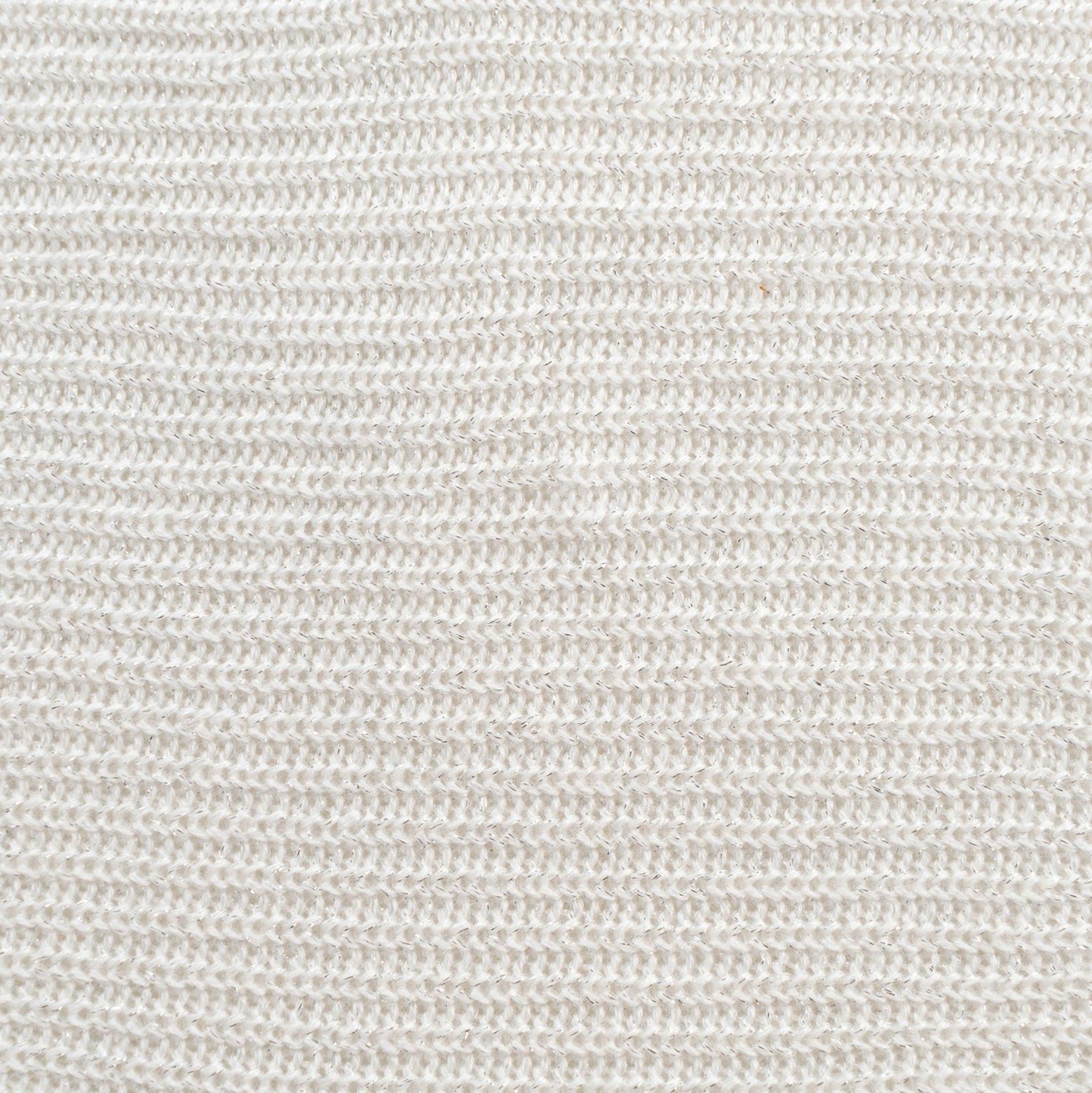

4 de março a 14 de maio de 2023
terça a sexta, de 10h às 17h
sábado, domingos e feriados, de 11h às 17h
Galeria do Lago – Museu da República
Rua do Catete 153, Catete – Rio de Janeiro - RJ afiar_expo
#afiarexpo #expoafiar #afiarnagaleriadolago
Presidente da República / President
Luís Inácio Lula da Silva
Ministra da Cultura / Minister of Culture
Margareth Menezes
Presidenta do Instituto Brasileiro de Museus / President of the Brazilian Institute of Museums
Fernanda Castro
Diretor do Museu da República / Director of the Repubic Museum
Mário Chagas
Coordenadora Técnica / Technical Coordinator
Lívia Murer
Coordenadora e Curadora da Galeria do Lago / Coordinator and curator of Galeria do Lago
Isabel Portella
Curadoria / curators

Isabel Sanson Portella
Filipe Chagas
Textos e Design / Text and Design
Filipe Chagas
Montagem e Iluminação / Assembly and Lighting
Adriano Trindade
Emerson Torres Ramos
Recepcionista / Recepcionist
Elizandra Bezerra da Silva
Cada homem age por si, segundo um plano próprio, mas o resultado é uma ação social, em que outro plano, externo a ele, se realiza; e com os fios crus, finos e desfeitos da vida de cada um, se tece a teia de pedra da história.
Radij Pogodin
autor russo
Uma palavra afiada corta tanto quanto uma faca. Seu fio mordaz é agudo e penetrante, com uma capacidade de transmitir mensagens incisivas de maneira mais profunda… E, muitas vezes, mais dolorosa. Uma palavra afiada também cria tramas, trança conceitos e, assim, seus fios conduzem a um horizonte ampliado… E, muitas vezes, transforma ideias pré-concebidas.
Em tempos de má interpretação geral e distorção intencional de qualquer texto – seja uma frase ou um discurso – uma plataforma de múltiplas possibilidades como a Arte é, então, uma afiadora de significados.
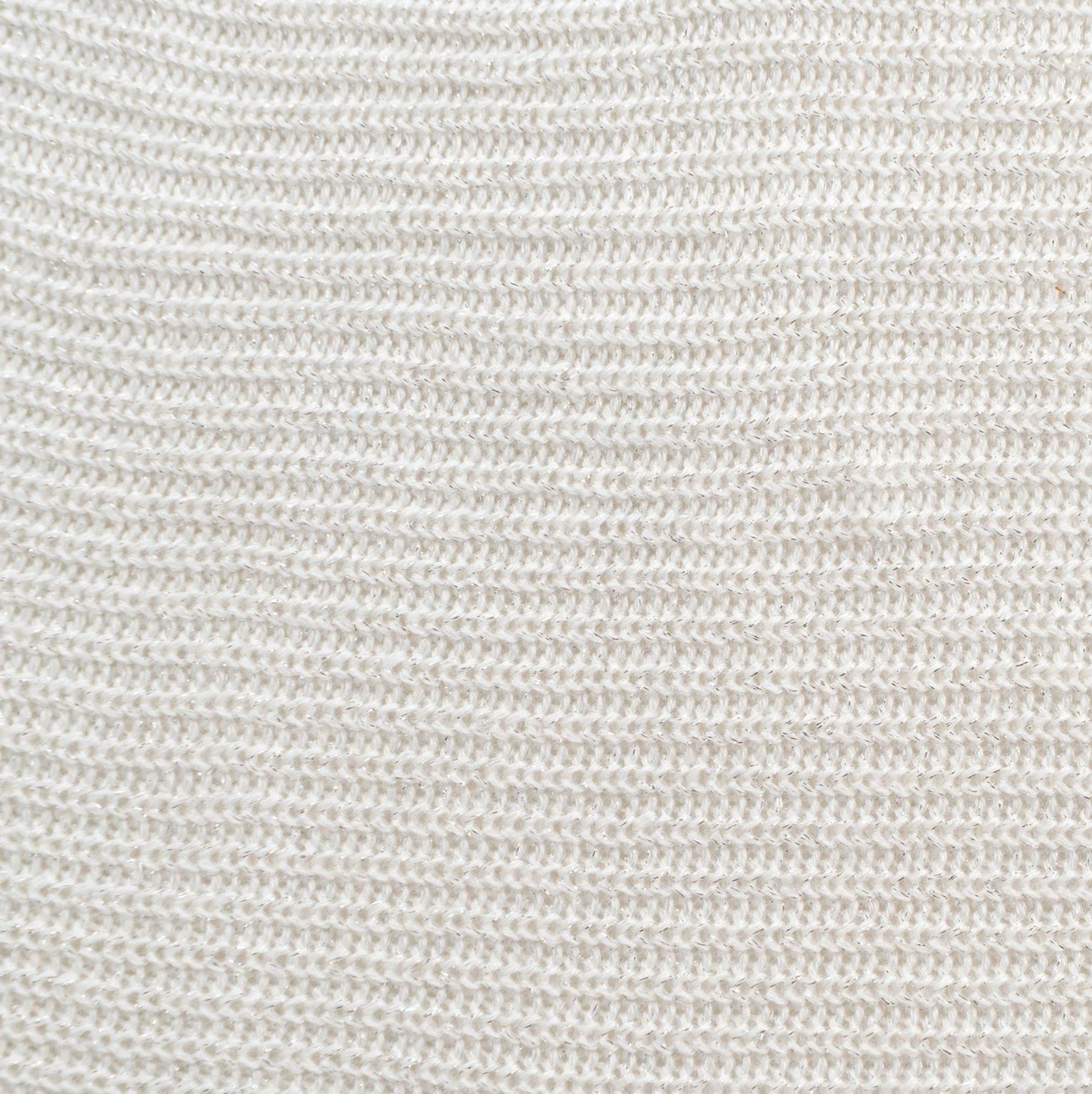
Na exposição coletiva A-FIAR, os artistas aperfeiçoam suas visões através do bordado. Historicamente visto como um passatempo feminino ancestral e artesanal, o bordado tem sido revisitado na contemporaneidade como importante forma de expressão biográfica e ativista que independe de gênero, raça, religião ou idade. A mesma agulha que fura, une. E, aqui, os artistas se unem para fiar e afiar sentidos. Eles apontam feridas que estão há muito abertas e já não possuem mais cabimento. Precisam ser suturadas. Suportes distintos e poéticas coletivas são atravessadas, ao mesmo tempo em que questões sociais fundamentais do nosso cotidiano são perpassadas. Fome, identidade de gênero, espiritualidade, conflitos armados, capacitismo, a relação do homem com o mundo… O ato de bordar deixa de ser uma mera decoração para se tornar uma palavra de ordem, um despertar.
Que essa experiência alinhave novas forças e costure novos vínculos para que mentes cada vez mais afiadas possam tecer uma existência cada vez mais digna.
Isabel Portella e Filipe Chagas curadores
Ana Bia Novais
A artista visual Ana Bia Novais (RJ) tem a fotografia como base de seu trabalho, onde sobrepõe materiais e técnicas para promover novos encontros e narrativas que ressignificam e deslocam a história de si mesma, das pessoas que fotografa e dos territórios que observa.
Em Muralhas, usa um elemento gráfico periférico marcado com a linha para materializar a força da mulher no enfrentamento à violência cotidiana, muitas vezes invisibilizada, que também carrega outras questões de identidade de gênero.
A artista participou das exposições coletivas Dá Caminho: imagens e vivências partilhadas, no Museu de Arte do Rio, Quermesse, no Instituto Inclusartiz, e Masculinidades em Diálogo, no Galpão Bela Maré.
É idealizadora do projeto Lambe das Manas, onde promove o ensino gratuito da fotografia popular, a disseminação desta linguagem da arte urbana e o fortalecimento de artistas dissidentes.

Muralhas, 2021
Fotografia digital, lambe lambe em papel offset bordado com linha de algodão cru e cola.

abnovais
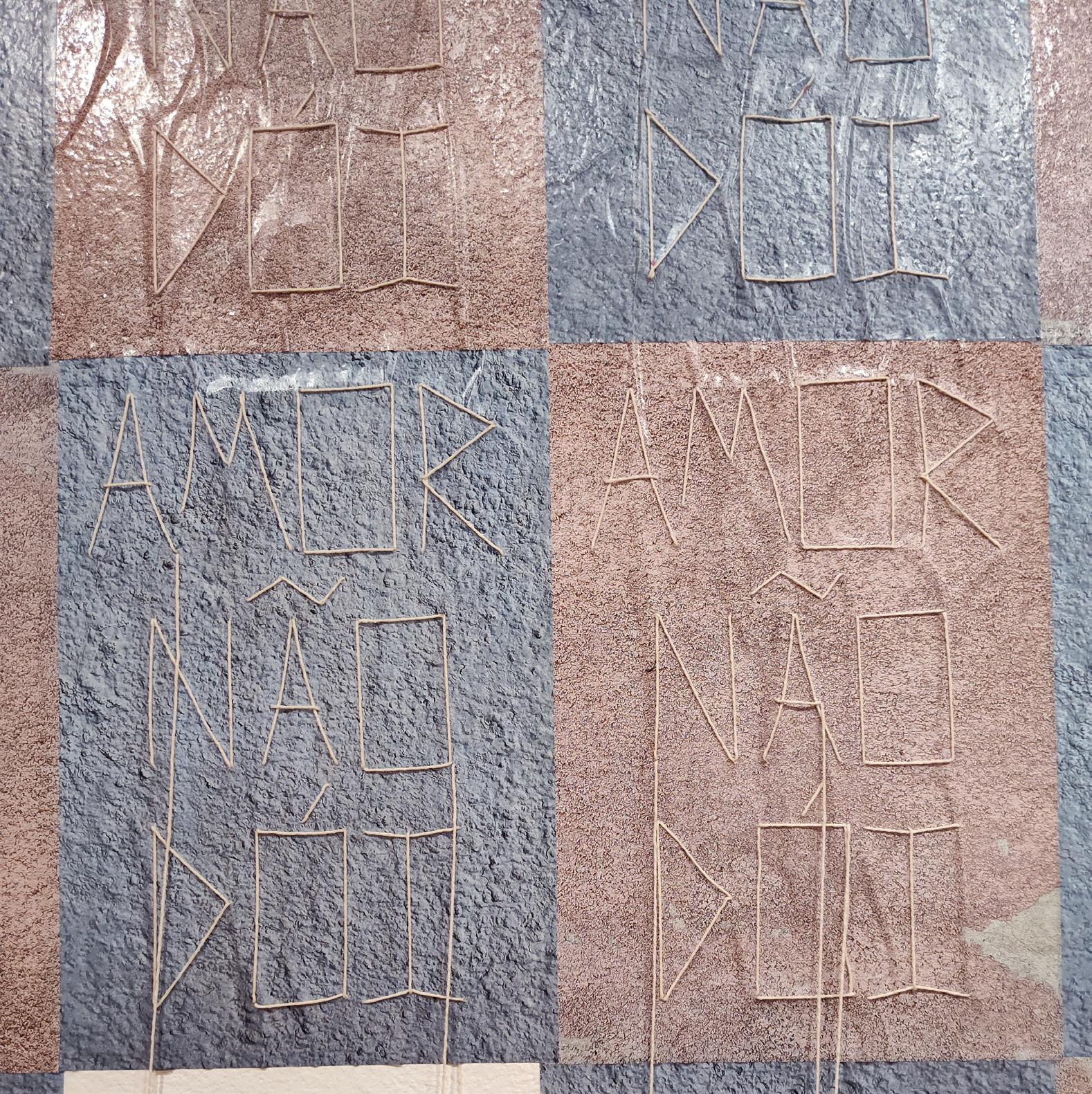
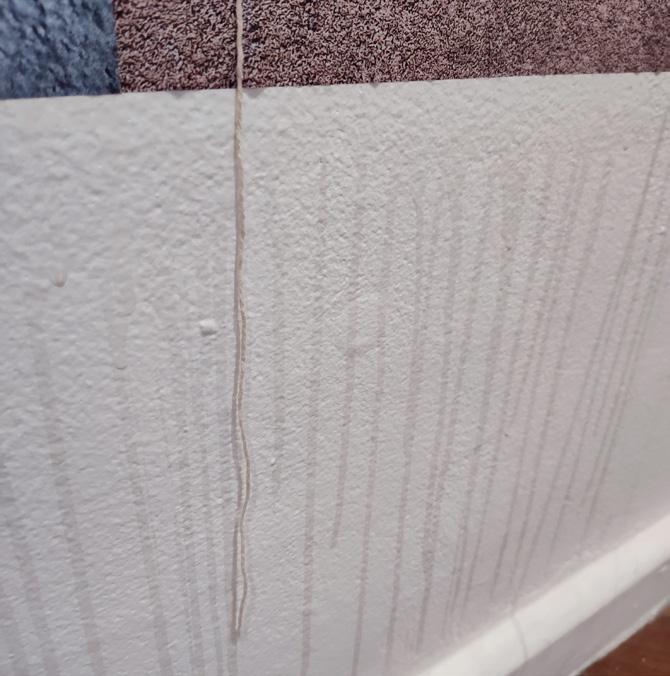

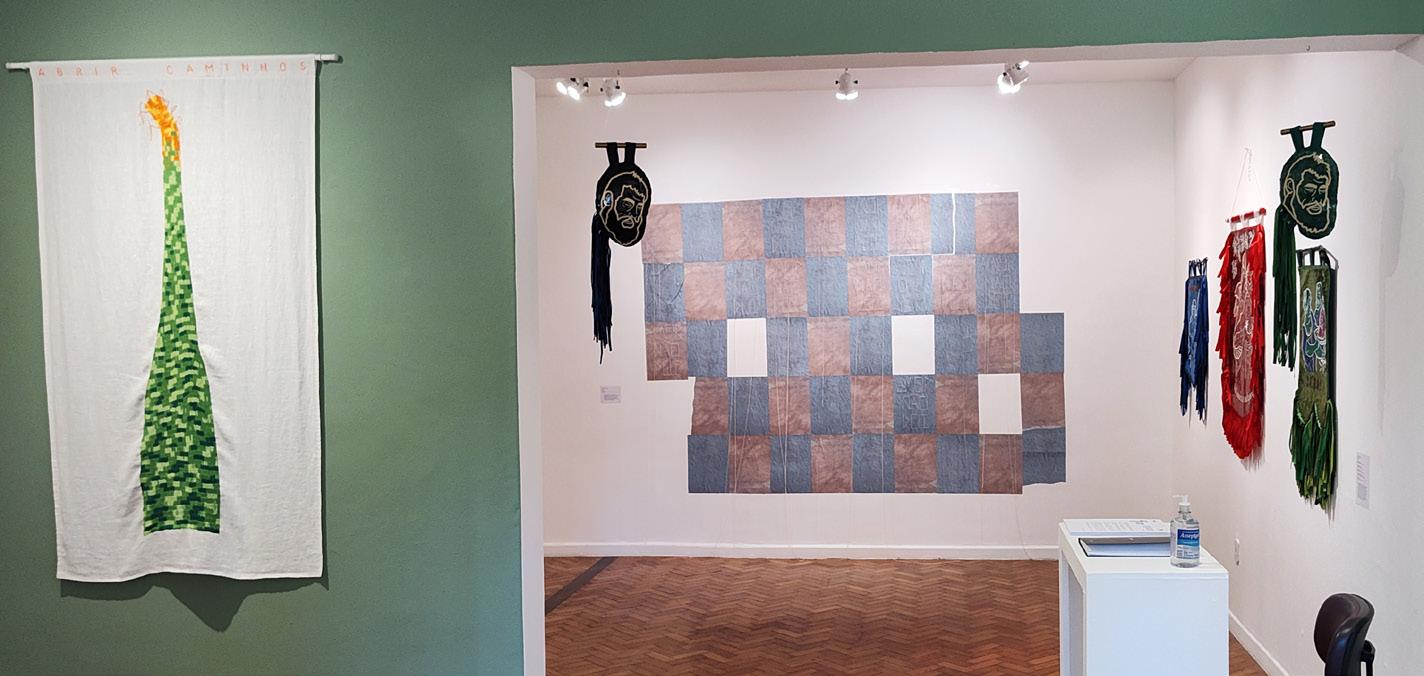
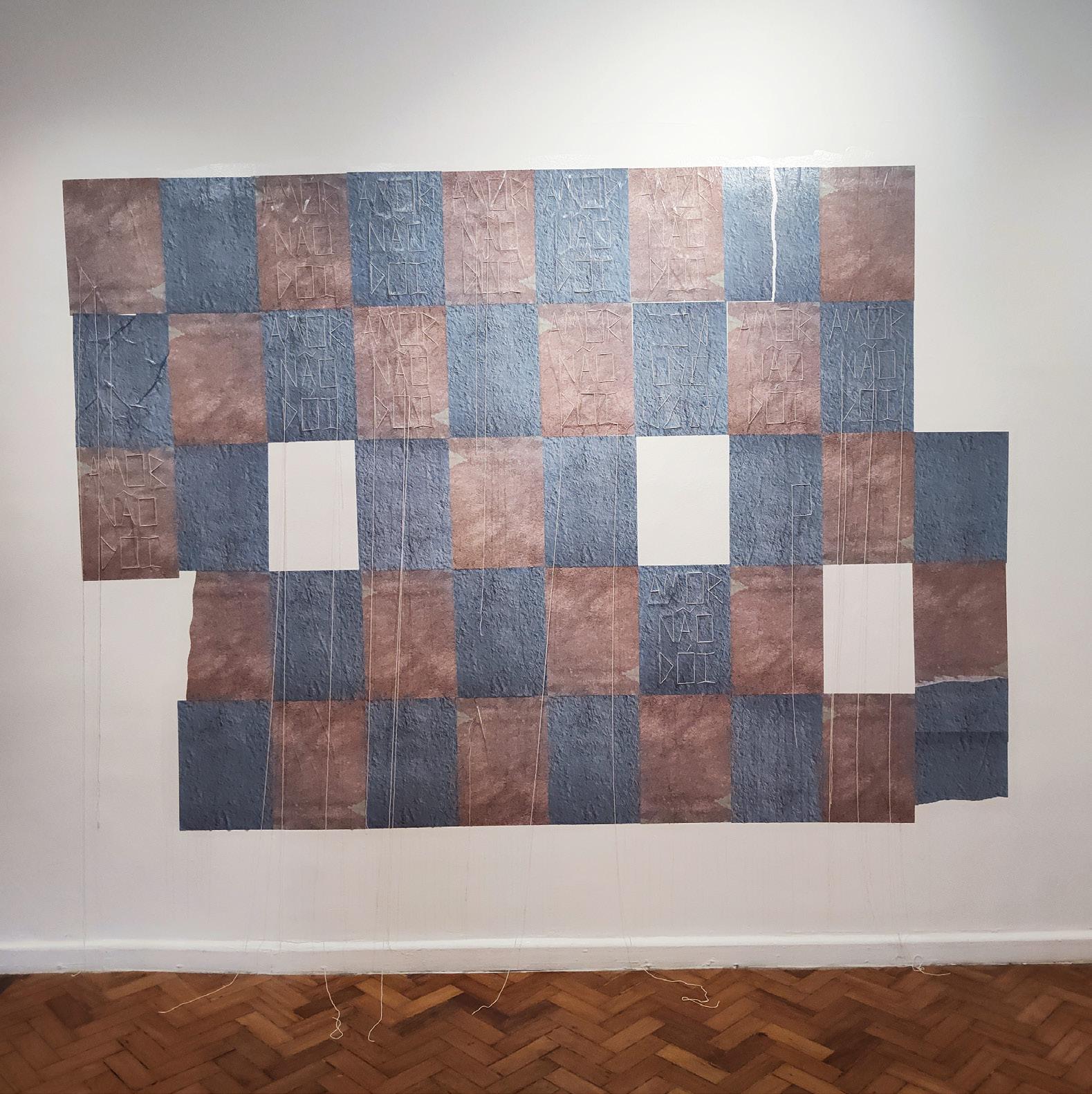
Bruna Amaro
abnovais
A artista visual, performer e pesquisadora Bruna Amaro (SP) apresenta em seus trabalhos uma combinação entre pesquisas acadêmicas e temas relacionados ao Carnaval, às religiosidades e à violência de gênero em busca de uma reflexão sobre o fazer têxtil a partir de questões que circulam pela realidade brasileira.
A imagem de duas mulheres bíblicas que enfrentaram a violência infligida por homens está em seus estandartes e acessórios de Carnaval, para jogar com o sincretismo e recordar que o número de assédio contra as mulheres sofre aumento vertiginoso neste período. Em To the left, a artista se utiliza das cores vermelho e preto associadas a Exus e Pombagiras para sugerir a interação tanto com um posicionamento político quanto com uma identificação religiosa.
Mestra em Estética e História da Arte pela USP e graduada em Artes Visuais pela UNESP, expôs em salões pelo Brasil e no exterior, com destaque para a performance e instalação Lavagem/Ablution, realizada no Bouge B Festival, na Antuérpia, junto a Juliana dos Santos e Daniel Lie (2018); o projeto Maneater, realizado durante residência artística na Bethany Arts Community, nos EUA (2019); e a performance e exposição individual As Papangus, realizada em São Paulo e em Berlim (2022).
Maneater (Salome), 2019

Galho de roseira, paetê e fita de cetim sobre tecido.
Artemísia vulgaris, 2019
Madeira, paetê e fita de cetim sobre tecido.
Maneater (Judith), 2019
Galho de roseira, paetê e fita de cetim sobre tecido.
Your head is my hand, boy, 2019
3 peças em barra de latão, paetê e fita de cetim sobre tecido.
To the left, 2020
Tinta acrílica sobre paetê bordado em tecido.

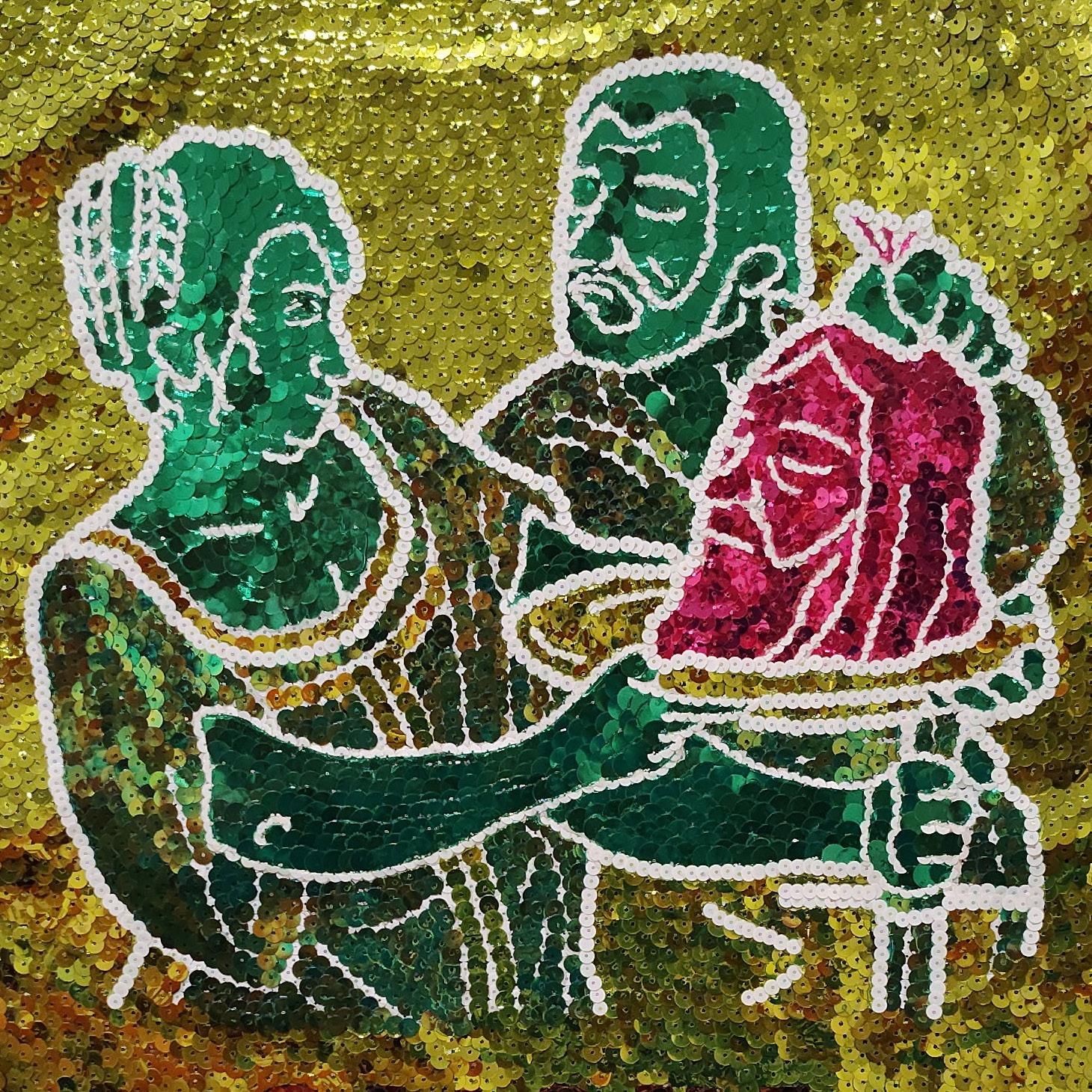
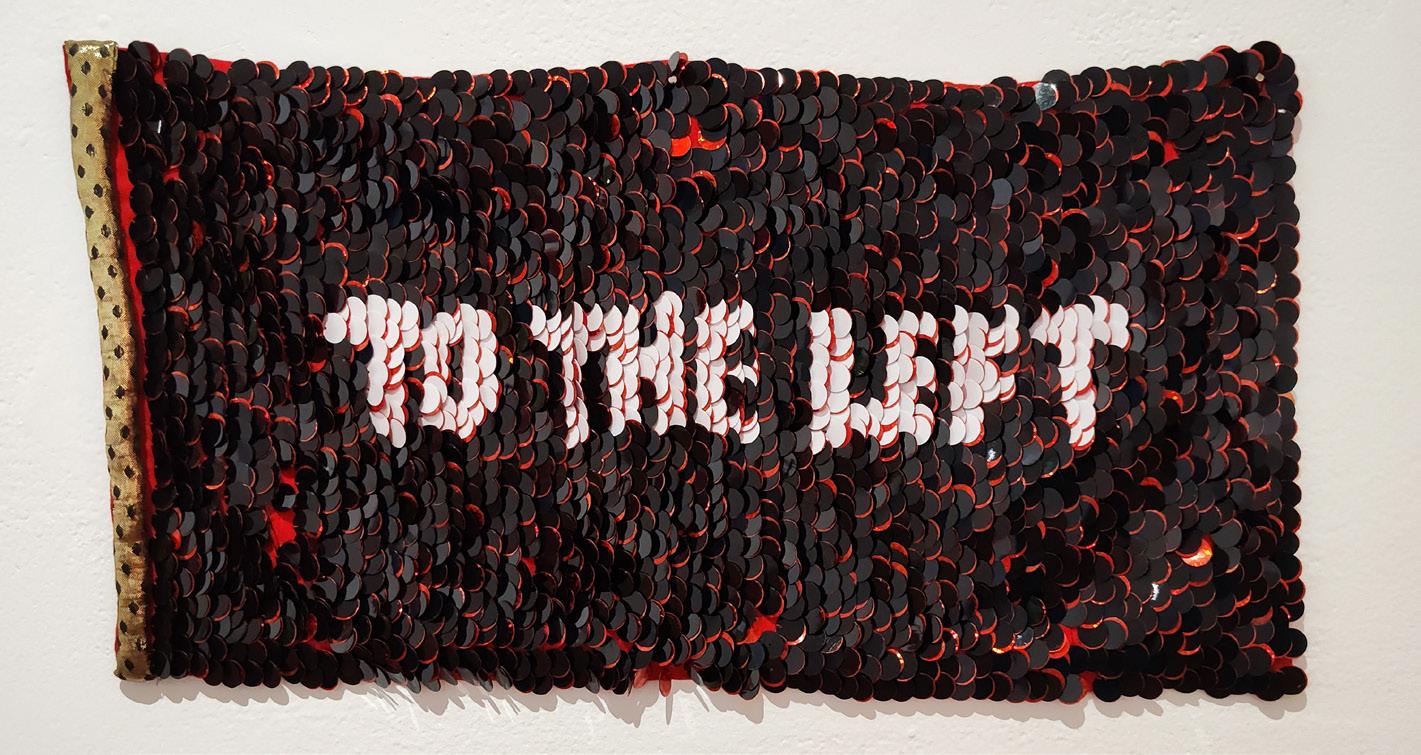


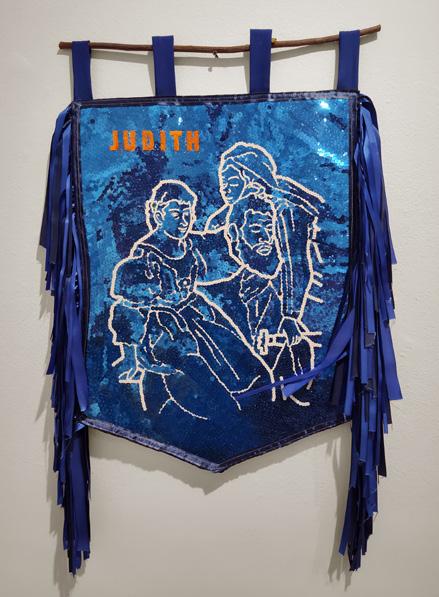
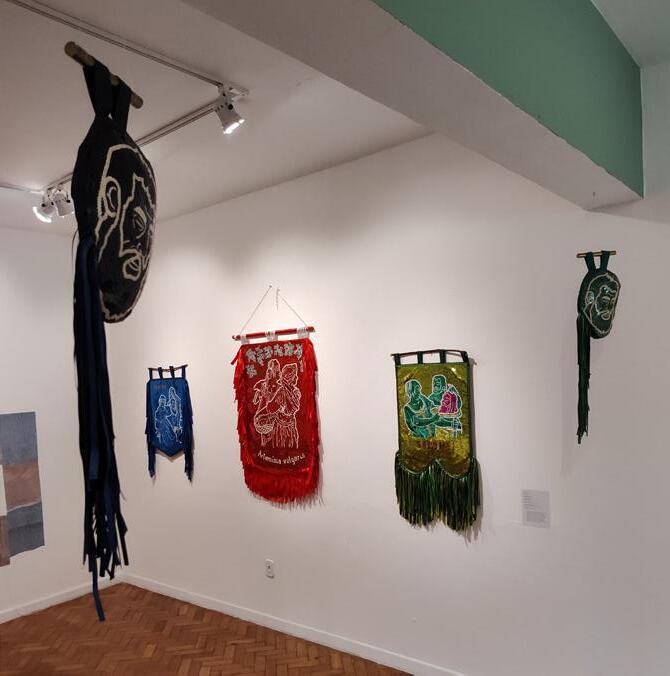
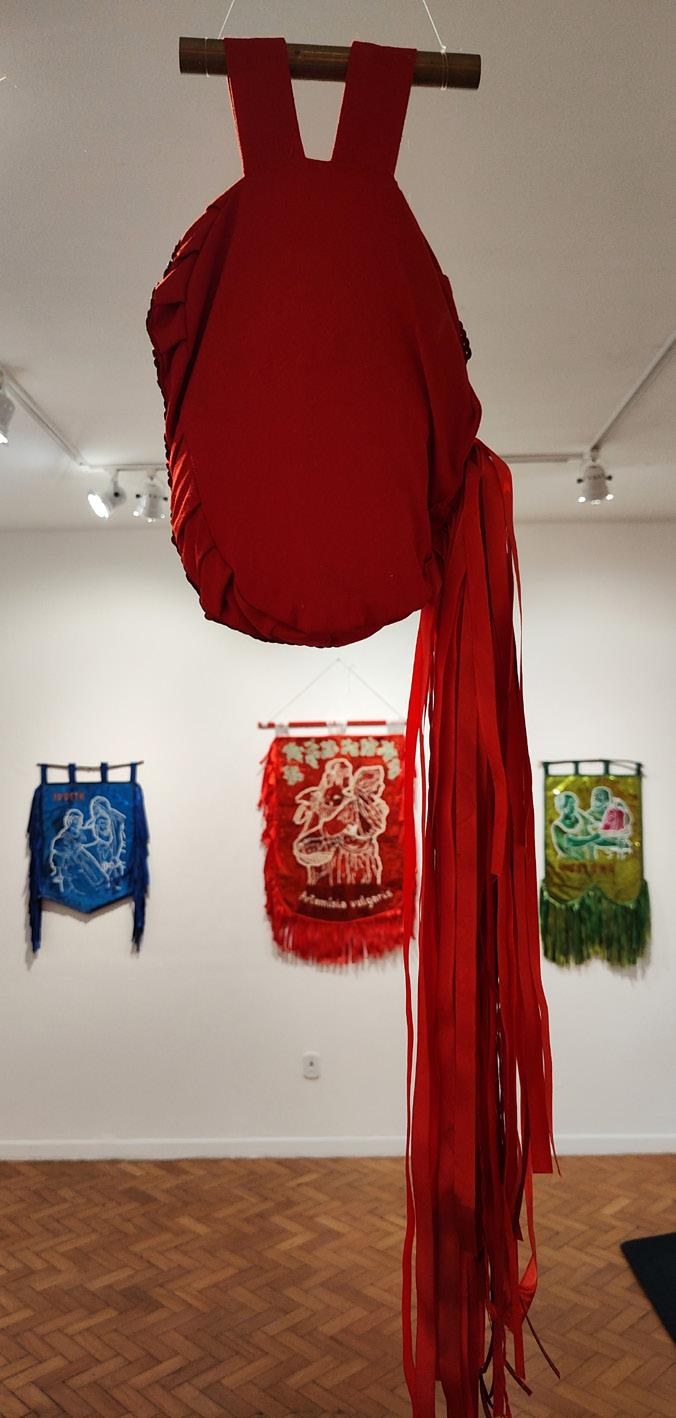

Julie Brasil
Julie Brasil (RJ) é artista visual e curadora, graduada em Pintura, mestre em Linguagens Visuais e doutora em Imagem e Cultura pela UFRJ. Atuou como professora de Desenho, de Imagem e Colonialismo na Escola de Belas Artes da UFRJ, e de Arte Contemporânea e Ditaduras Latino Americanas em instituição particular. Desenvolve sua produção em meios múltiplos com particular interesse em temas de política, consumo, ironia e violência. Como artista, participou em exposições em instituições nacionais e internacionais, como Caixa Cultural, Instituto Cervantes, Festival de Vídeos de Kassel e Museu Brasileiro de Escultura, entre outros.
A moça que colocou uma flor no fuzil de um soldado em um protesto sobre a Guerra do Vietnã em Washington (EUA). O jovem que ficou em pé diante de um tanque blindado em um protesto na Praça da Paz Celestial, em Pequim. Gestos de paz em momentos de grande tensão levam a artista ao arsenal que sua família mantinha em casa durante a guerra civil na Guatemala, seu país de origem, e também à lenda maia das Quitapenas, diminutas bonecas guardiãs que atuam como ouvintes, levando aos deuses as preocupações daqueles que se dirigem a elas de coração aberto para que encontrem uma maneira mais clara e leve de resolvê-las. Daí resultou a série de bordados das armas que, em suas pontas, carregam uma boneca mágica tanto como resistência quanto como munição de proteção e paz.
juliebrasil

Quitapenas Canhão, 2023

Quitapenas Bazuca, 2020
Quitapenas Pistola, 2023
Quitapenas Arco e Flecha, 2020
Quitapenas Catapulta, 2023
Quitapenas CM176, 2020
Bordado manual e industrial em lona e boneca Quitapenas.



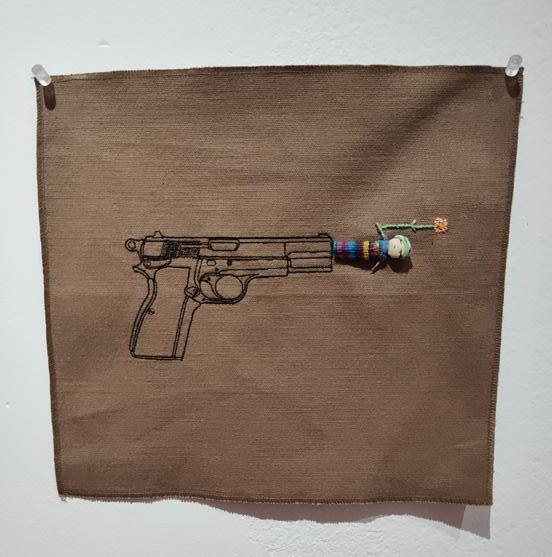
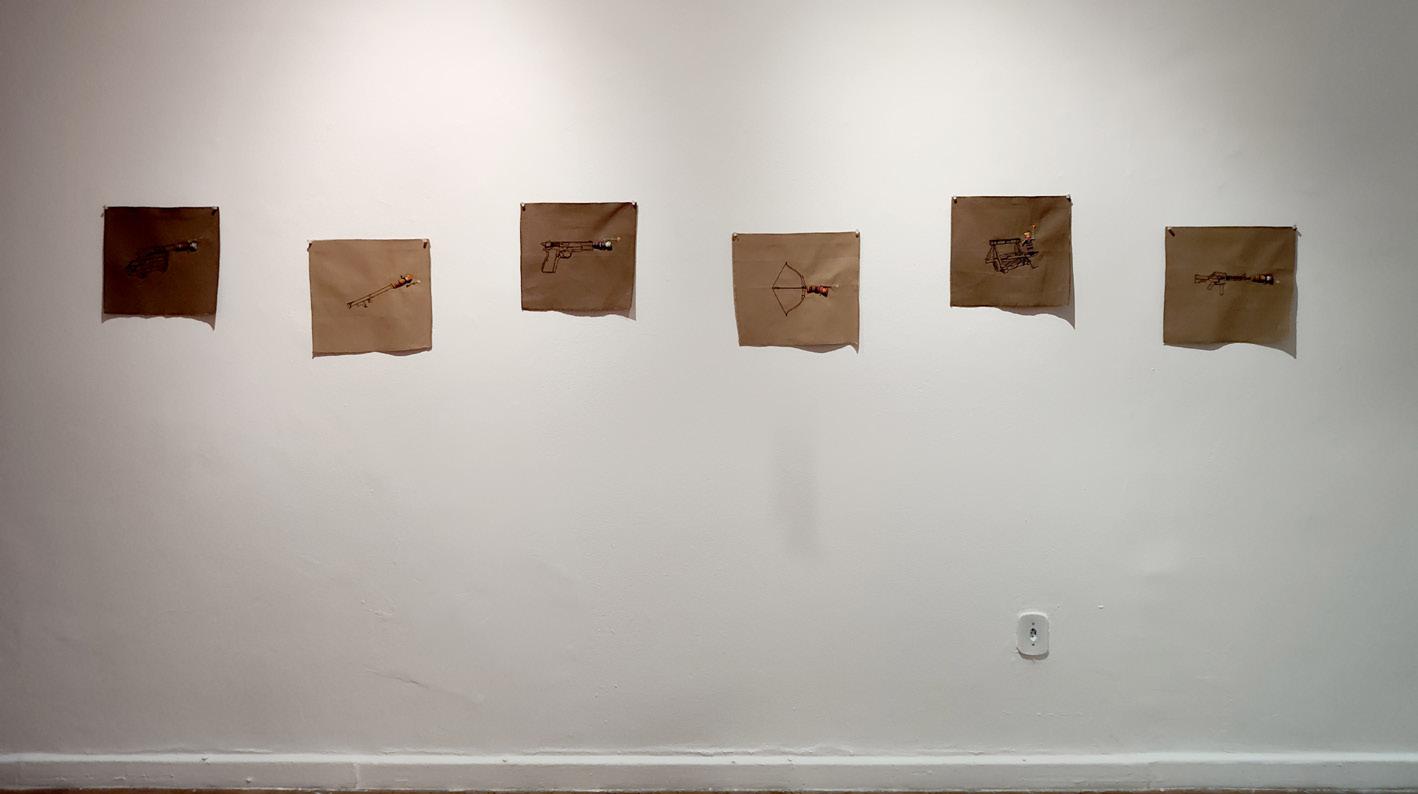
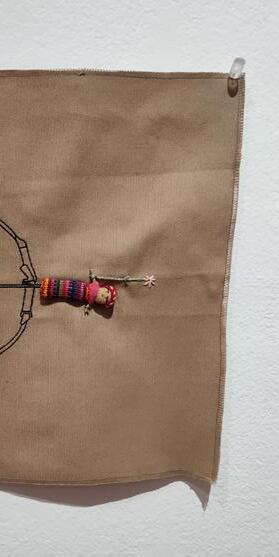

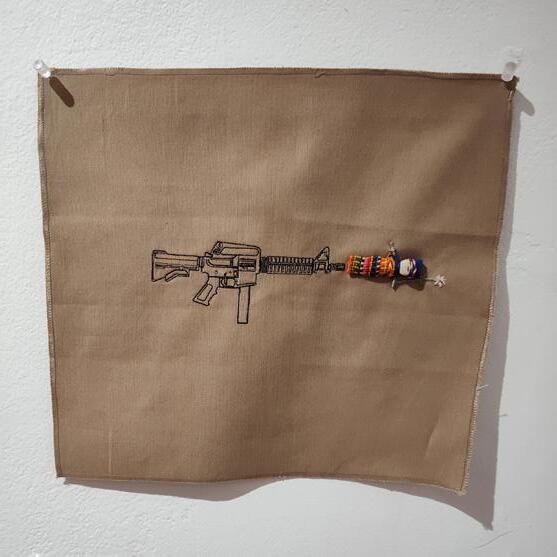

Langattomasti
O coletivo Langattomasti (RJ) – formado pela artista plástica e geocientista Giselle Parno e a artesã, artista têxtil e engenheira química Thainá Melo – explora os desdobramentos do tecer para refletir sobre toda e qualquer forma de arte com fios. Desde 2014, atuam em diversas frentes, tendo como propósito resgatar e propagar a arte de tramar fios, seja em fotografias, figurinos, artesanatos ou mesmo intervenções urbanas (yarn bombing) e “crochês protesto”.

As imagens nesta exposição trazem três intervenções realizadas pelo coletivo: um violão de crochê no busto de Chiquinha Gonzaga, localizado no Passeio Público do Rio de Janeiro, representando a influência da música afrodescendente em seu repertório e lembrando a execução da música “Corta-jaca” pela primeira dama de Hermes da Fonseca, Nair de Teffé, em um recital no Salão Nobre do Palácio do Catete; e duas mantas crochetadas contendo símbolos da cultura dos povos escravizados e originários nas duas estátuas femininas em terracota dos Jardins do Catete, que buscam evidenciar que, apesar de ornamentado de forma europeia, o palácio considerado da e para a elite pertence a todos os povos e culturas que formam este país.
Diáspora 2, 2023

Fotografia de yarn bombing em estátua de terracota, Jardins do Palácio do Catete/RJ.
Manta diaspórica com grafismos indígenas, 2023
Croché tradicional em fio de algodão.
Diáspora 1, 2023
Fotografia de yarn bombing em estátua de terracota, Jardins do Palácio do Catete/RJ.
Manta diaspórica com adinkras, 2023
Crochê irlandês em fio de algodão.
Maxixe, 2023
Fotografia de yarn bombing na estátua de Chiquinha Gonzaga, Passeio Público/RJ.
langattomasti
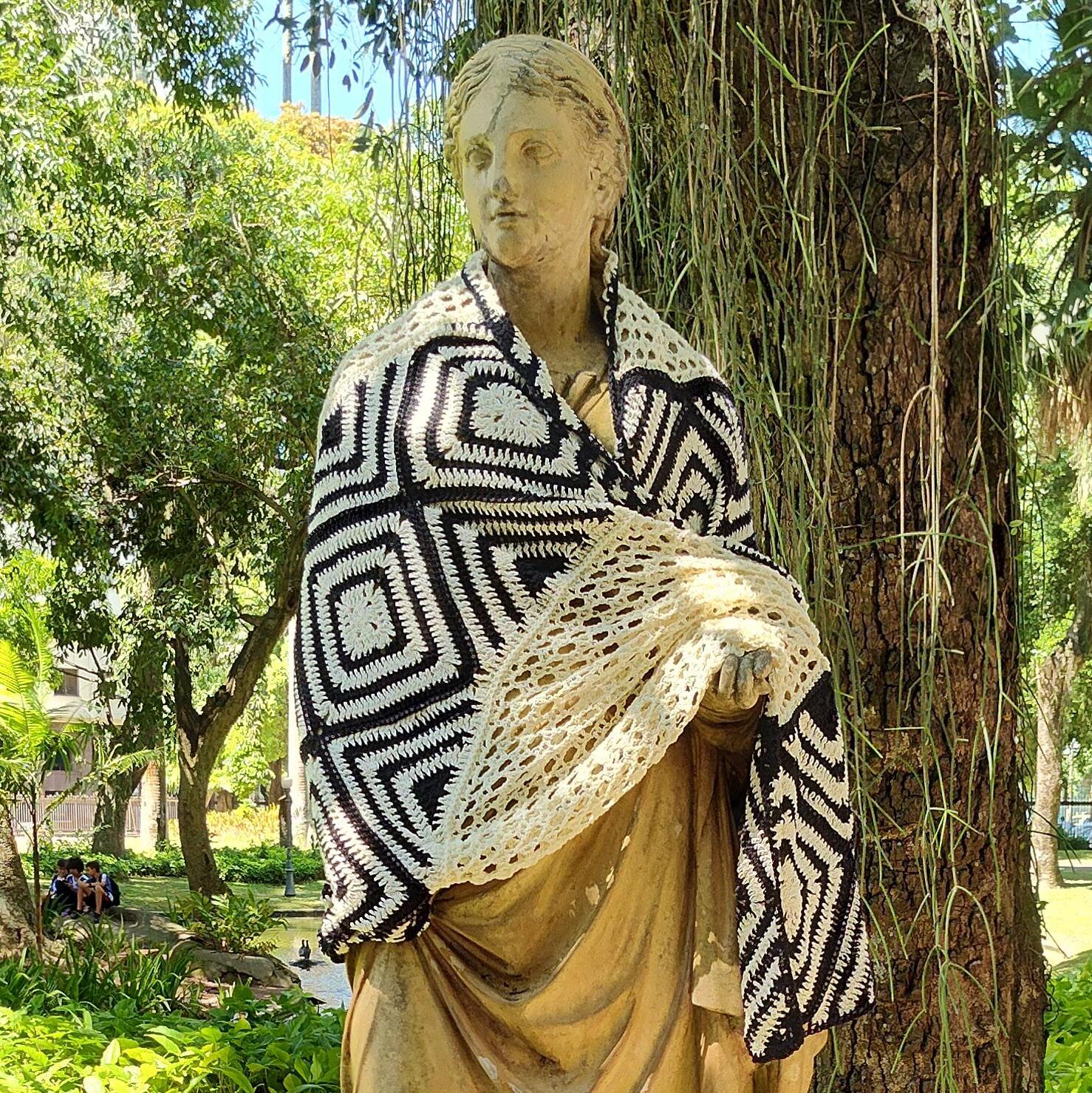
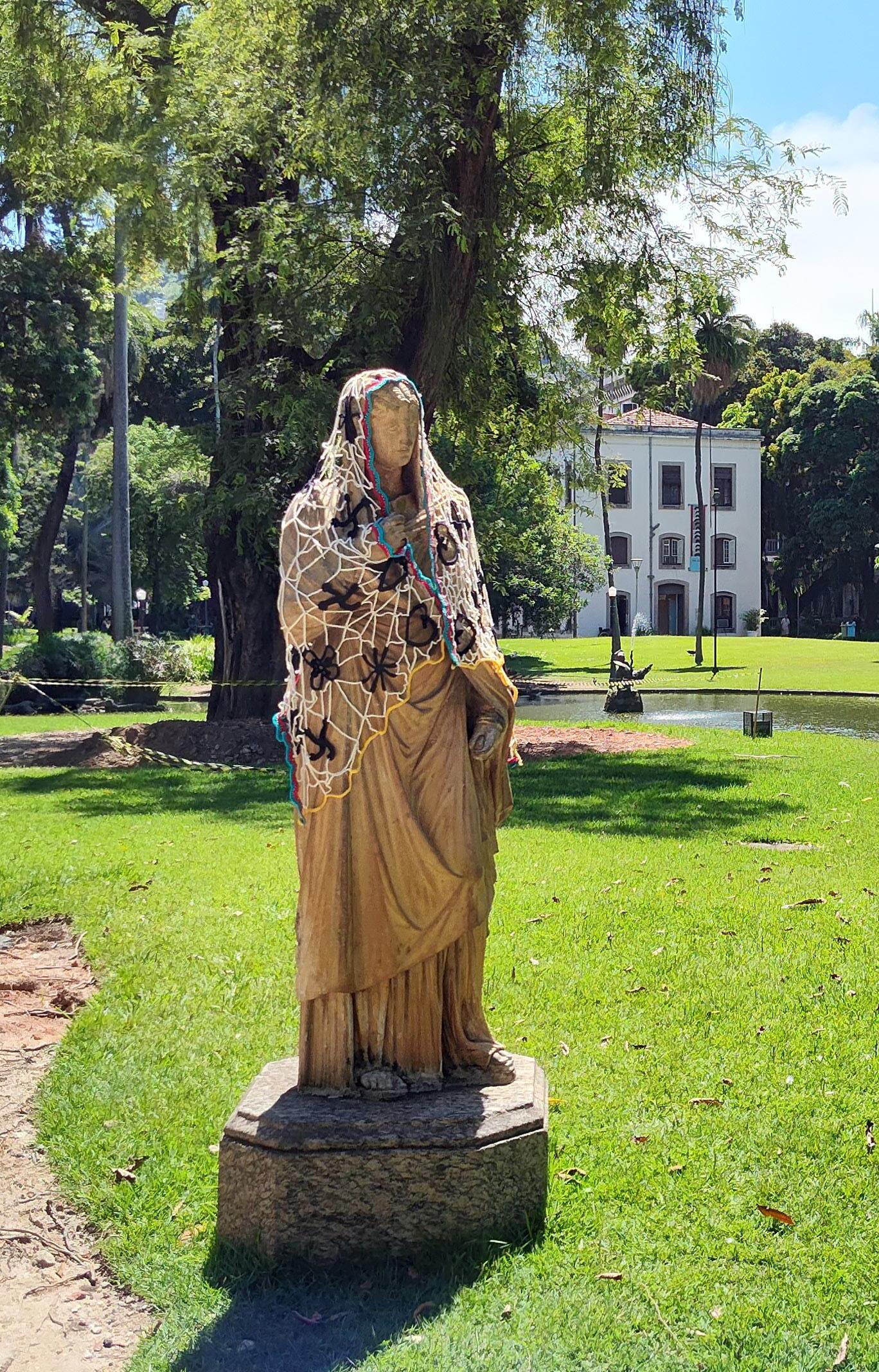


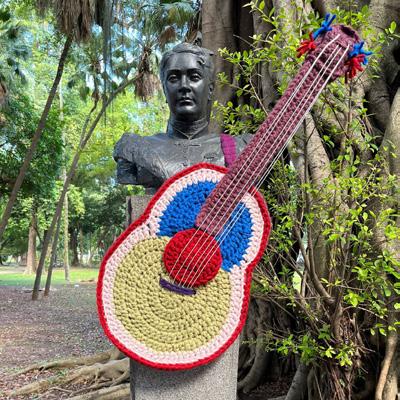
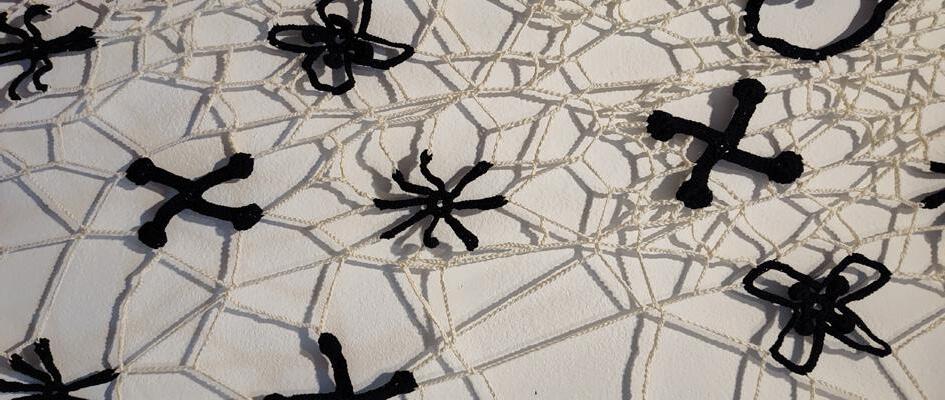
Marcos Rossetton
Marcos Rossetton (SP) investiga o comportamento humano, social e midiático através de mensagens polarizadas, antagônicas e subliminares, tendo como foco sexualidade, conscientização e respeito à diversidade. Na desconstrução de objetos e no uso de materiais diversos, compõe uma assinatura única sempre provocando o espectador.
Seus bordados são subversivos e visam o questionamento disruptivo não só da ordem estabelecida, mas também dos suportes tradicionais da técnica. Em marmitas plásticas, por exemplo, o artista borda reflexões sobre o isolamento experienciado por todos durante a pandemia que, na verdade, são intrínsecas à contemporaneidade. Afinal, o que nutre nossa alma em tempos difíceis? Em tempos onde somos espectadores e vítimas das disputas de poder que saíram dos bastidores para a permanência no cotidiano? Bastidores estes que são igualmente parte do universo do bordado e aqui são utilizados para esticar o látex amazônico atravessado por imagens da nossa capital em favor do capital.
Formado em Artes Visuais, pós-graduado em Imagem e Styling de Moda, e premiado no evento Casa de Criadores, fez residência artística no Museo Q de Bogotá. Suas obras já percorreram a EroticArt London, a Biennale
Internationale Design de Saint-Étienne, o Centre de Design de Marseille, o Museu Histórico Nacional (RJ), o Museu da Diversidade Sexual e o Centro Cultural da Diversidade (SP).

Marmitas congeladas!, 2021
6 embalagens plásticas bordadas com linha e fotografias em jogo americano impresso em PVC.
Nos bastidores da nação: Fé no agronegócio!, 2020
Látex, linha, agulha e aviamentos.

Nos bastidores da nação: Arminha na mão índio no chão, 2020
Látex e linha.
rossettonjobs
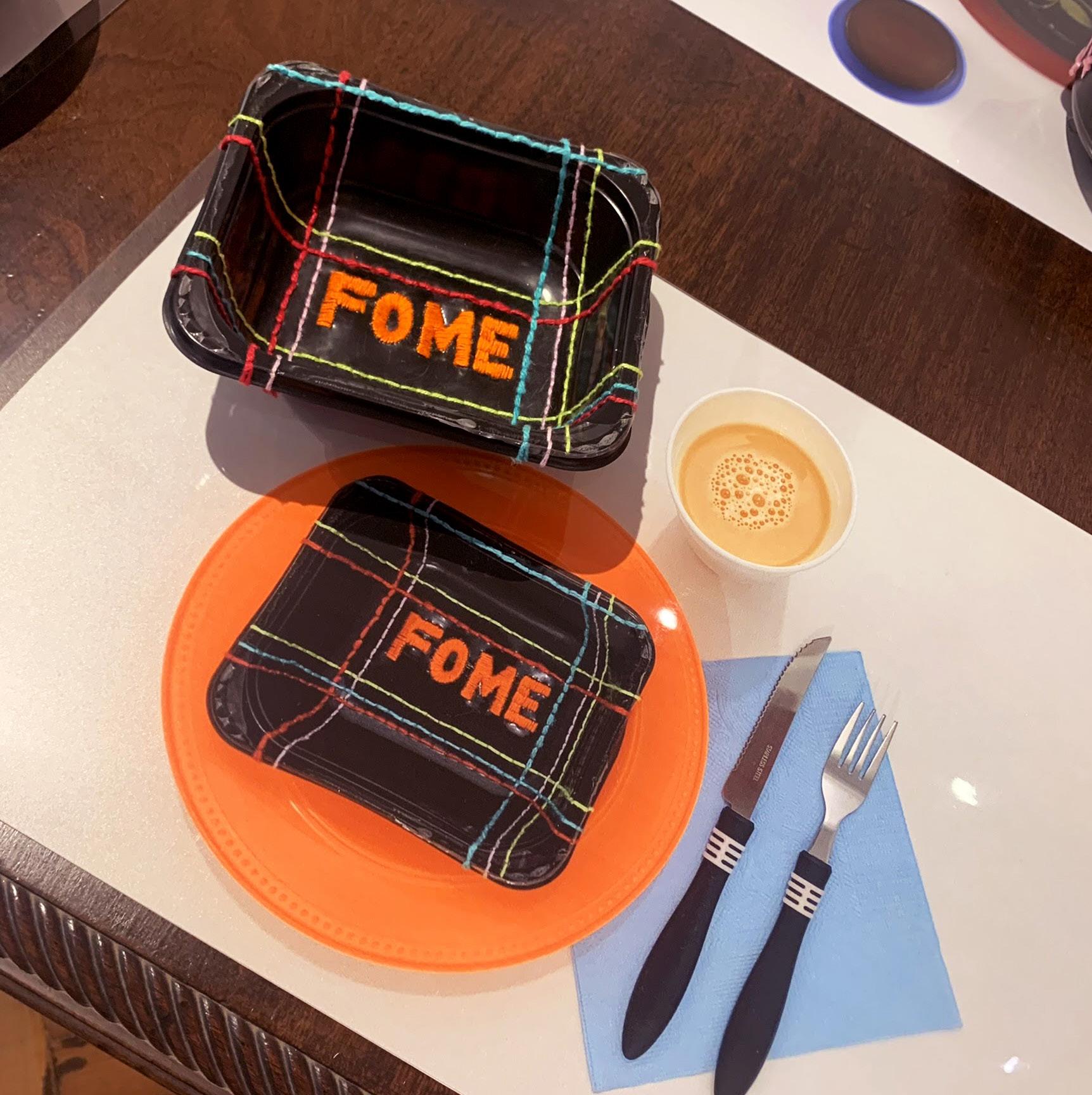
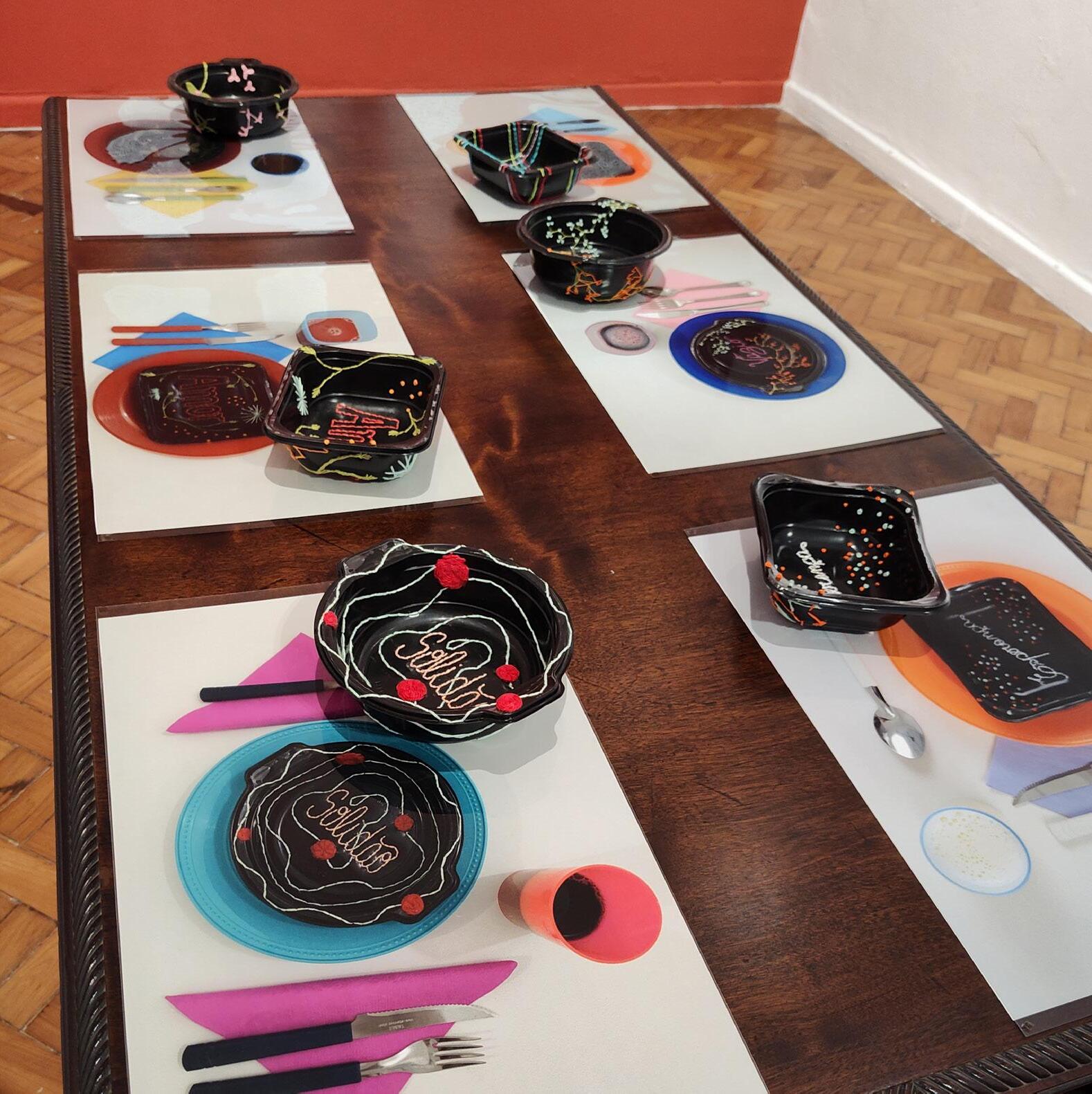
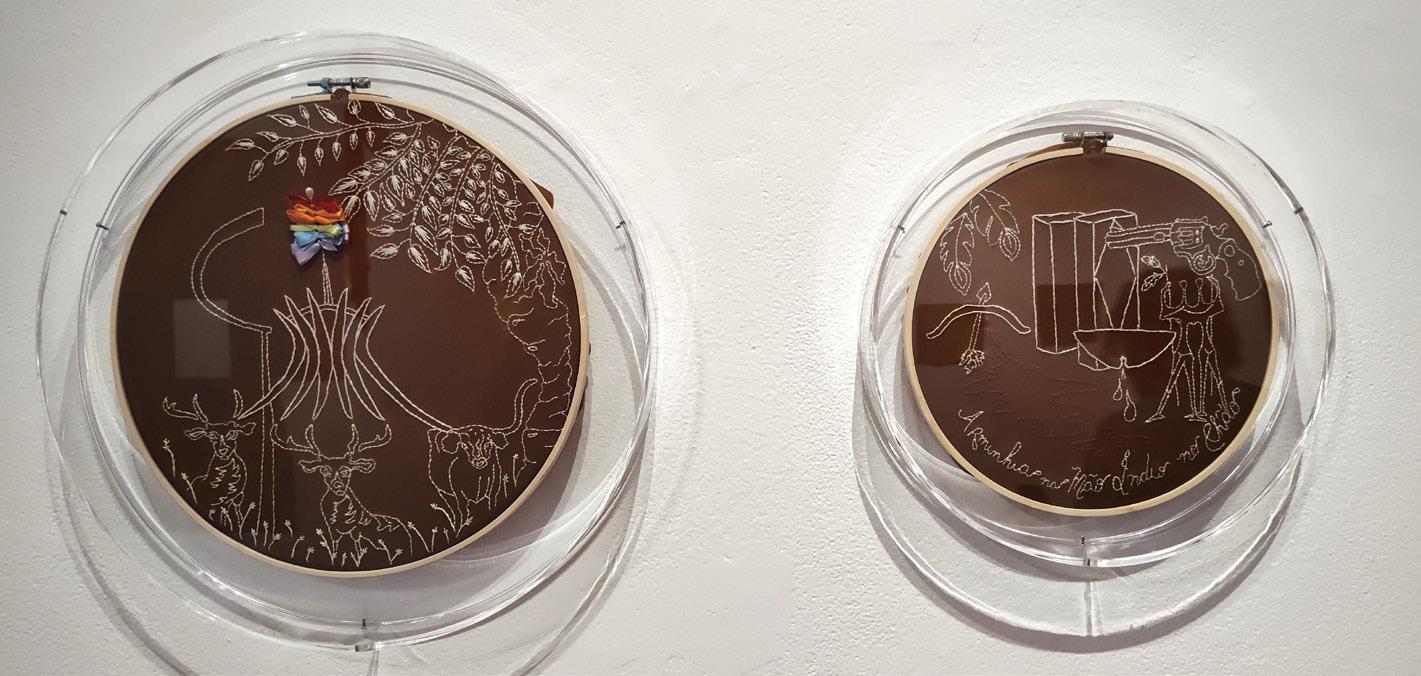
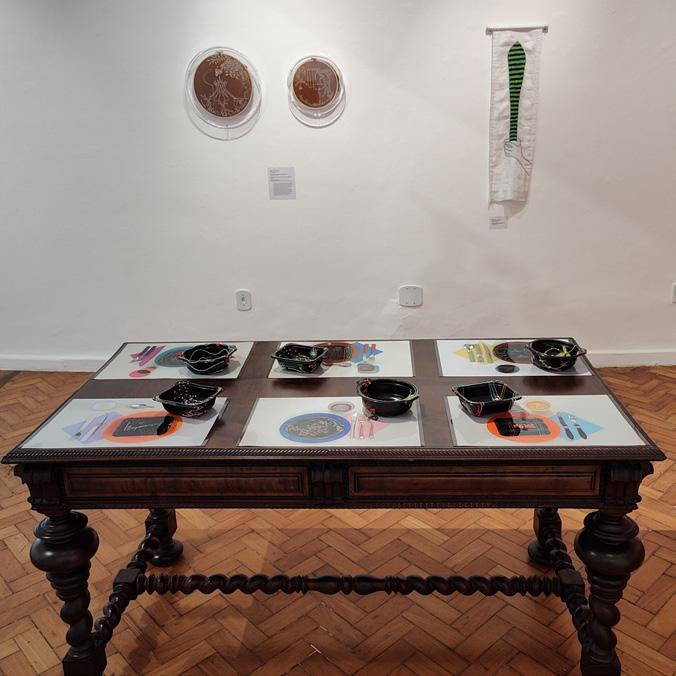
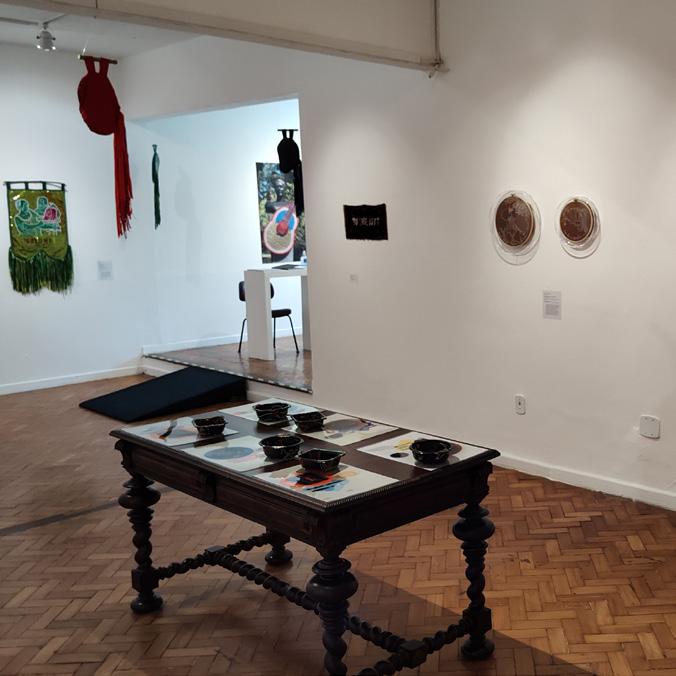
Mariana Vilela
Mariana Vilela (MG) é artista multimídia e ativista. Mestranda em Divulgação científica e cultural pelo Labjor/Unicamp, atua como performer desde 2010, transitando por artes visuais, teatro e literatura. Tem a linha como objeto conceitual e perspectiva de pensar e atuar no mundo.
Para contrapor a Era geológica em que vivemos –marcada pelo impacto da presença do ser humano na Terra, o Antropoceno – a artista propõe pensar as linhas vegetais com suas cooperações, simbioses e co-contaminações, deixando-se tomar pelas plantas. Com Vitaloceno, para uma cabeça vegetal, a artista possibilita outras narrativas e convoca a força vital das plantas como perspectiva central da criação de mundos.
Participou de exposições individuais e de diversos salões de arte contemporânea no Brasil. Ganhou



prêmio Funarte de Artes Visuais - Periferia e Interior, em 2018, com o projeto Em Diálogo. Nasceu em Belo Horizonte, e hoje vive em Campinas.
marianavilela.art
Vitaloceno, para uma
cabeça vegetal, 2021
Objeto feito de linha e plantas cultivadas.
Stills do vídeo da performance.

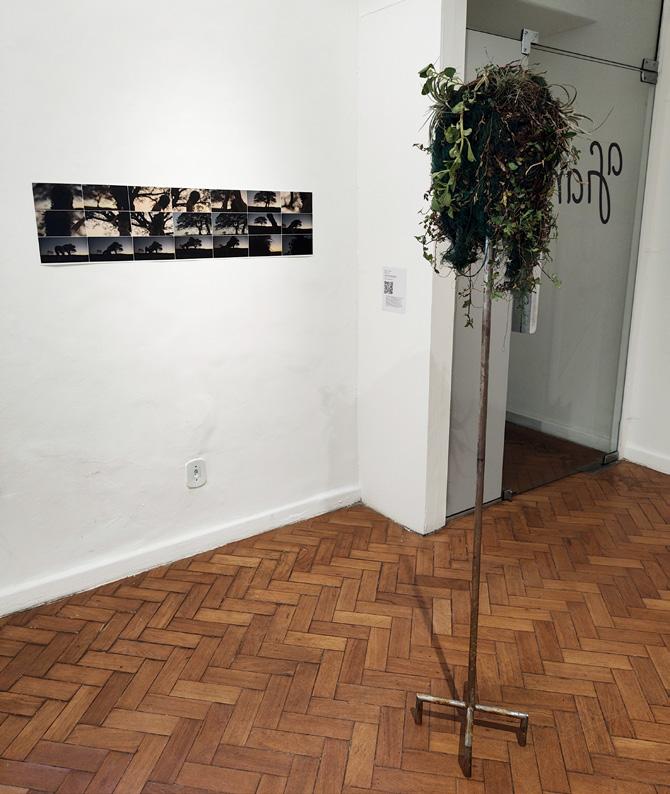

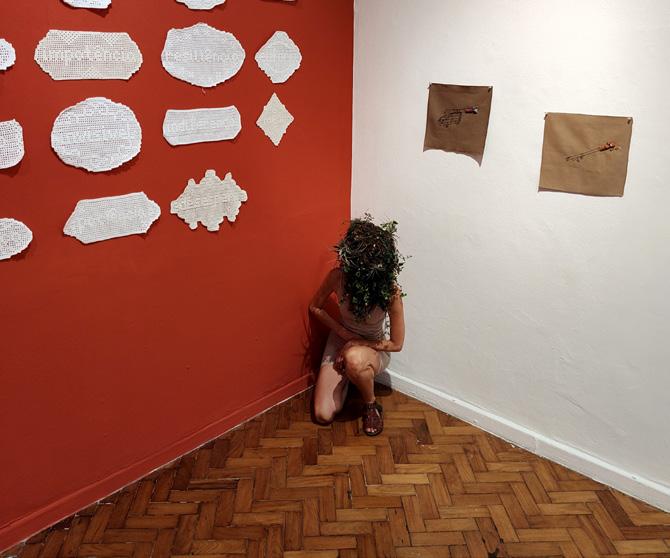

Nara Rosetto
A partir da vivência de doenças crônicas sem cura, Nara Rosetto (SP) se utiliza dos temas da vulnerabilidade, invisibilidade, dor e corpo como assuntos recorrentes em sua produção. Em Pimenta no olho do outro, a expressão popular brasileira “pimenta no olho do outro é refresco” foi a referência para o uso da pimenta (um analgésico natural) como matéria prima de tingimento dos fios que foram trançados em expressões que estão enraizadas em nossa sociedade capacitista. Já os dezoito crochês de Pequenos Gestos se aproveitam do contraste de branco sobre branco para dificultar a leitura de sentimentos invisibilizados.
Formada em Arquitetura e Urbanismo pela Universidade Presbiteriana Mackenzie, é mestranda em Artes Intermídias na Faculdade de Belas
Artes da Universidade do Porto. Trabalha em diferentes suportes como peças têxteis, vídeo e foto performance, a partir da vivência de doenças crônicas sem cura. Participou da blauverschiebung performance festival no.14, na Alemanha, da Every Woman Biennial, em Nova York, da Porto Femme no Porto e fez parte da residência artística Demonstra.pt.

Vive e trabalha no Porto, em Portugal.
nararosetto
Pimenta no olho do outro, 2018-2019
Crochê em fio de algodão cru.

Pequenos gestos, 20202023
18 objetos de crochê em fio de algodão.

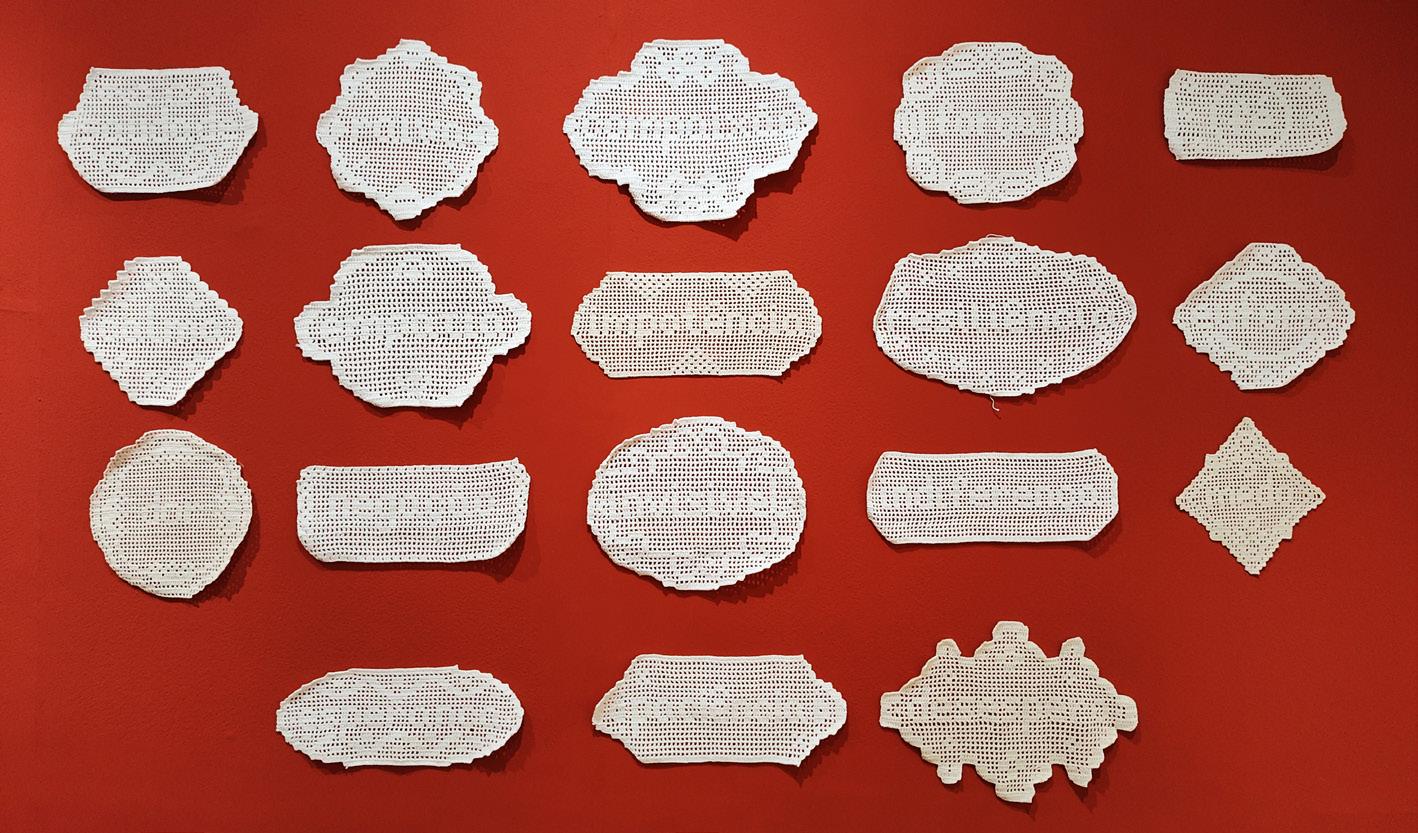



Rafael Dambros

Com a “pintura de agulha”, o artista plástico Rafael Dambros (Caxias do Sul/RS) usa as múltiplas cores da linha de costura como matéria-prima do traçado sobre uma tela. Em seu São Sebastião como jogador de futebol, a agulha reflete as flechas do martírio do santo padroeiro do Rio de Janeiro, que é representado à exaustão e sincretizado no Brasil com Oxóssi, o orixá caçador das matas. A sobreposição das linhas cria camadas de luz, sombra, leituras e provocações. Surge um novo ícone brasileiro, forte, livre e cheio de contrastes: entre as representações clássicas e a iconografia pop, entre o homoerotismo e o machismo no esporte, entre o sagrado e o profano.

Seus desenhos e bordados servem como expressão de identidade LGBT e espaço para discussão sobre temáticas sociais. Além de possuir obras em acervos públicos e particulares do Brasil e Europa, participou de inúmeras exposições individuais e coletivas em Caxias do Sul, Porto Alegre, Rio de Janeiro e também virtuais. Seu trabalho mais marcante foi a exposição Santificados (2018), que trazia releituras de ícones católicos com linguagens contemporâneas e questionadoras do status social. Essa exposição foi censurada pela prefeitura de Caxias do Sul, porém, gerou uma enorme discussão sobre liberdade de expressão artística que levou a mostra para a Câmara de Vereadores da cidade.
São Sebastião como jogador de futebol, 2022 Bordado em tela com fundo de tinta acrílica branca e dourada.
rafaeldambros
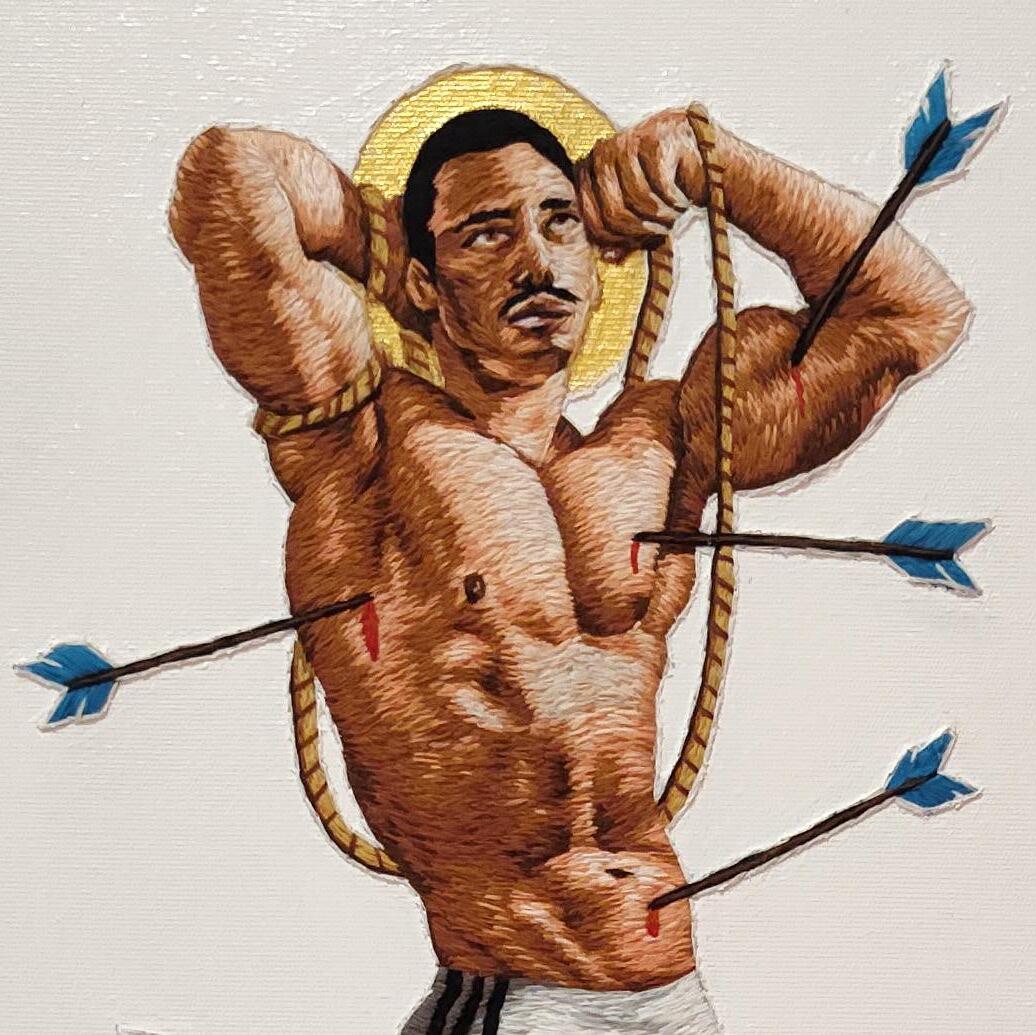
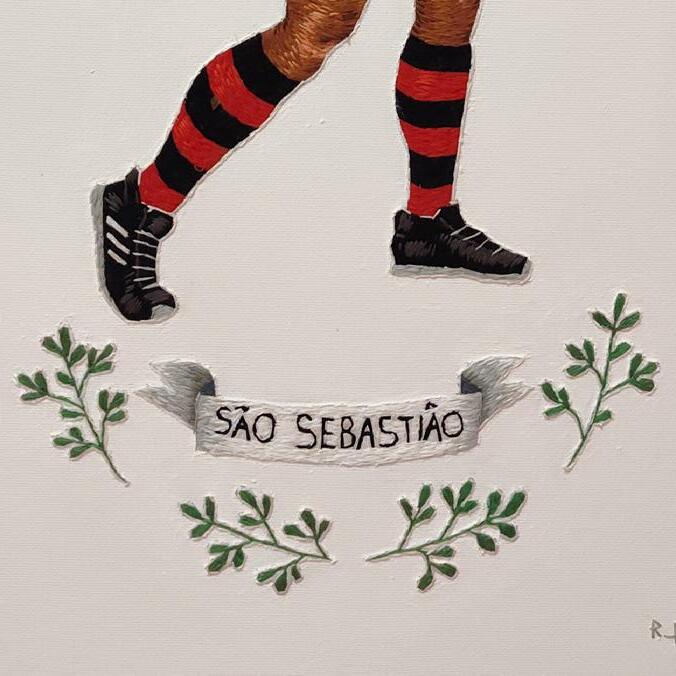
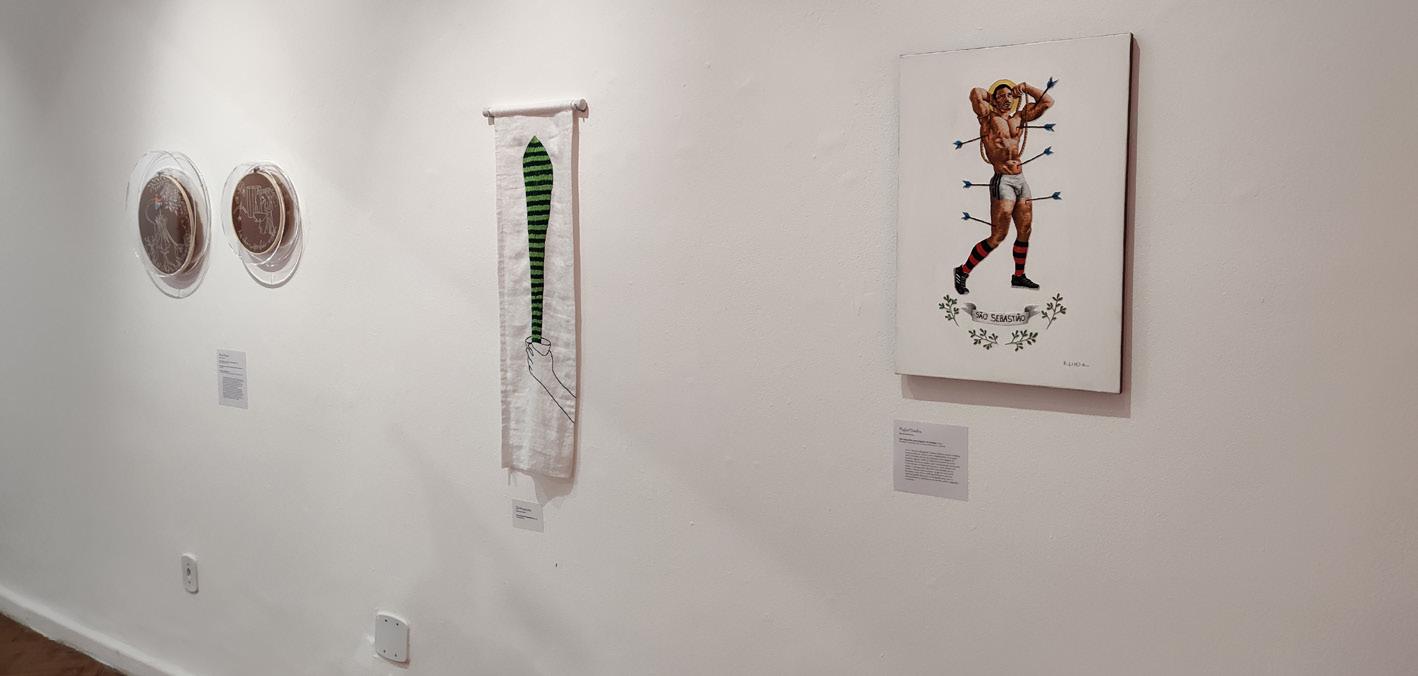
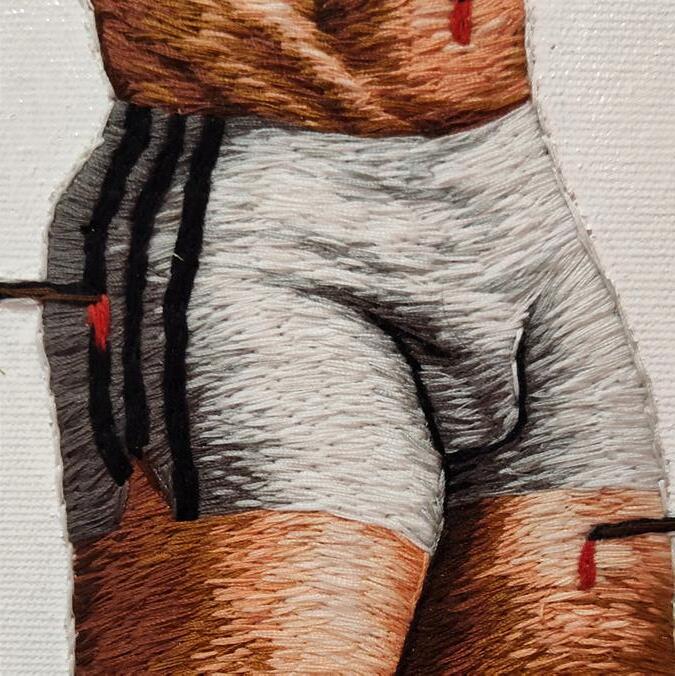
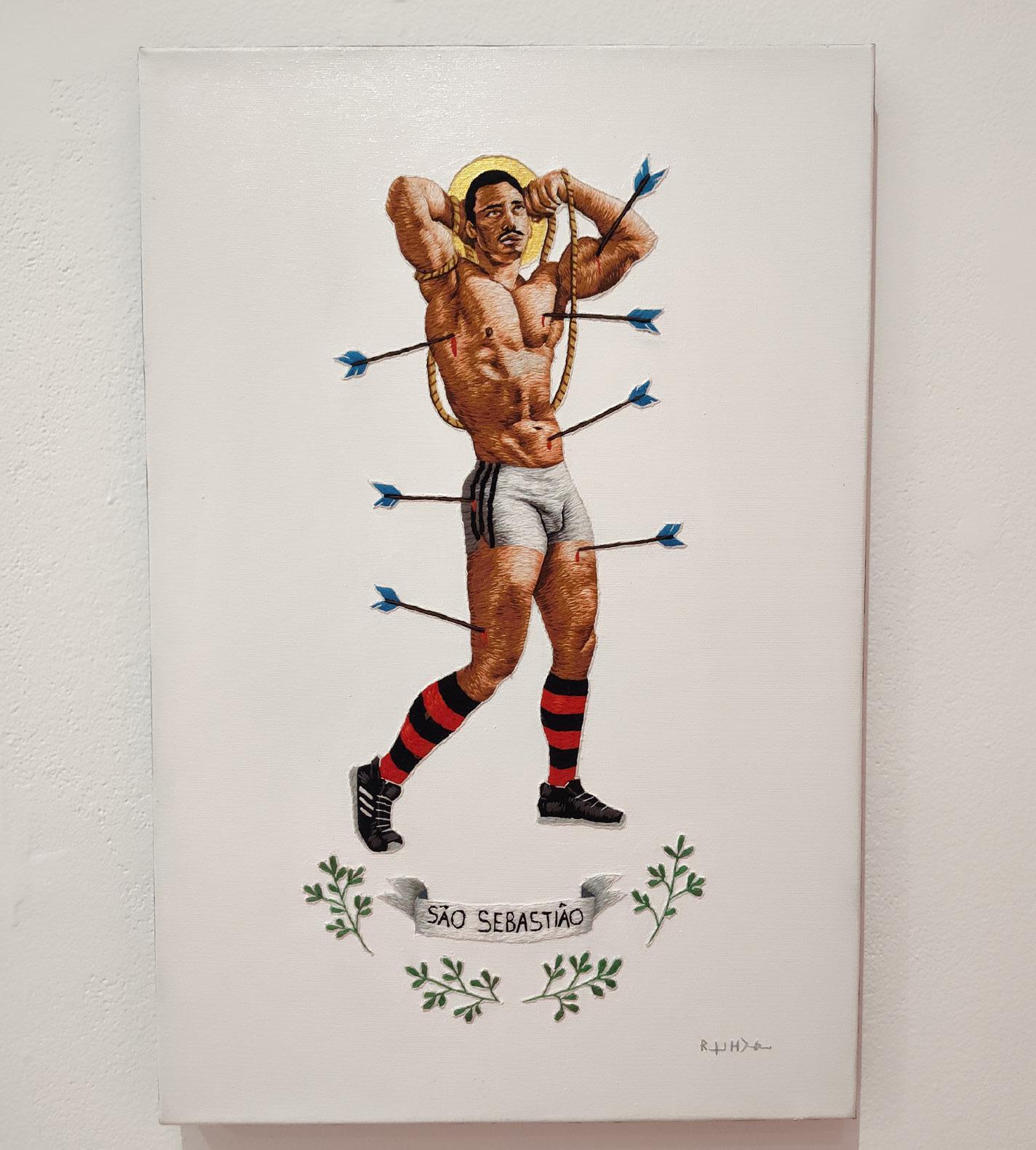
Yuli Anastassakis
Atenta à repetição de palavras e expressões que indicavam os rumos da nação, Yuli Anastassakis (RJ) começou a realizar um mapeamento de discursos sobre o tempo presente, onde encontrou, de modo geral, tanto um temor advindo da ignorância quanto uma potente esperança carregada de afetos. Como uma forma de reação ao momento em que vivemos, resolveu associar sua pesquisa de palavras à imagem da Espada-de-São-Jorge, uma planta muito popular por ser forte, resistente, viver bem em solos pobres e com pouca rega, além de ser vista como uma forma de proteção contra mau-olhado e inveja, especialmente nas religiões de matriz africana. Assim, a artista abre os caminhos para pensarmos em um novo modo de ser e estar no mundo, de refletir e agir, de comunicar e cooperar.
Graduada em Ciências Sociais na IFCS/UFRJ, é mestre em Processos Artísticos Contemporâneos pela UERJ. Trabalha como produtora de/para Arte desde 1998. Como artista visual desenvolve pesquisas em bordado, colagem, fotografia e pintura. Participou das residências artísticas O sentido do Fio (RJ/2018) e Flora (RJ/2019). Em 2021, realizou a individual Tempos de Agora, no Espaço
NowHere, em Lisboa. Participou de diversas coletivas no Rio de Janeiro, em São Paulo e Lisboa. Vive e trabalha em Lisboa.

Abrir caminhos, 2023
Linha sobre linho.
#proteçãoparatempossombrios, 2022
Linha sobre linho.

yuli.anastassakis

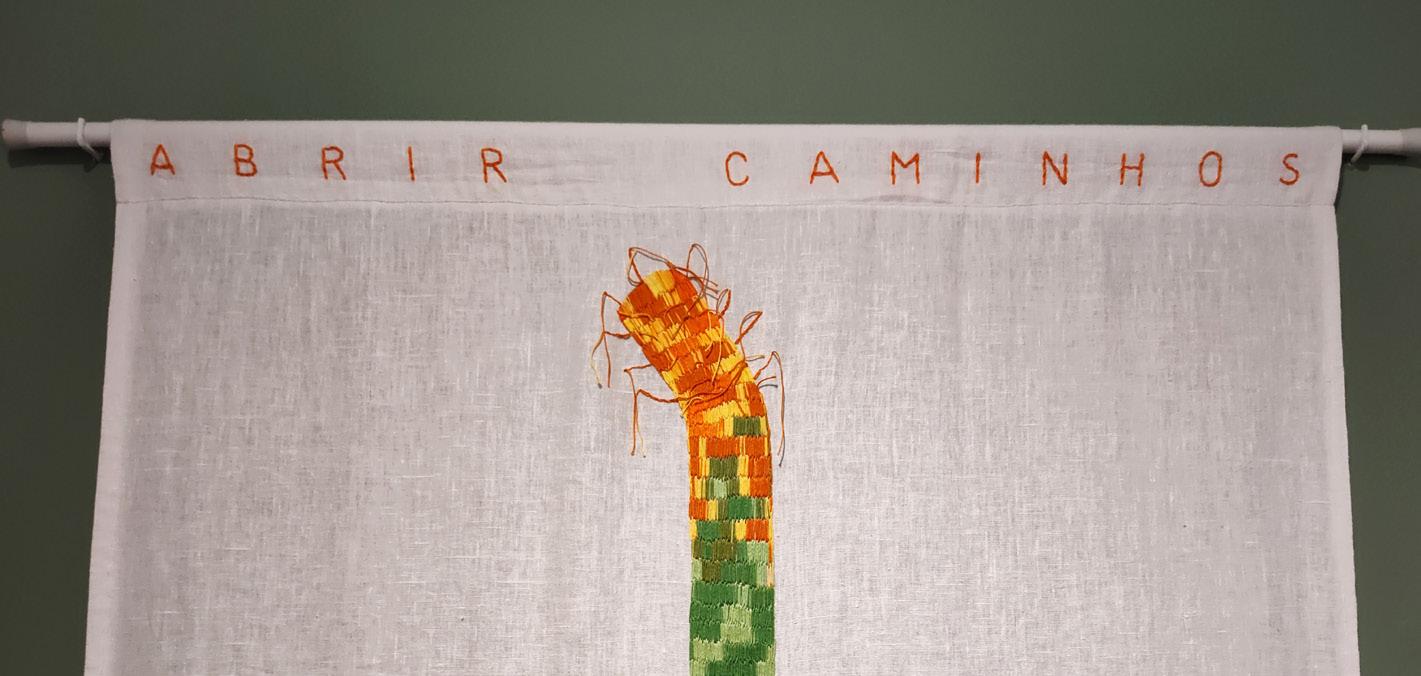
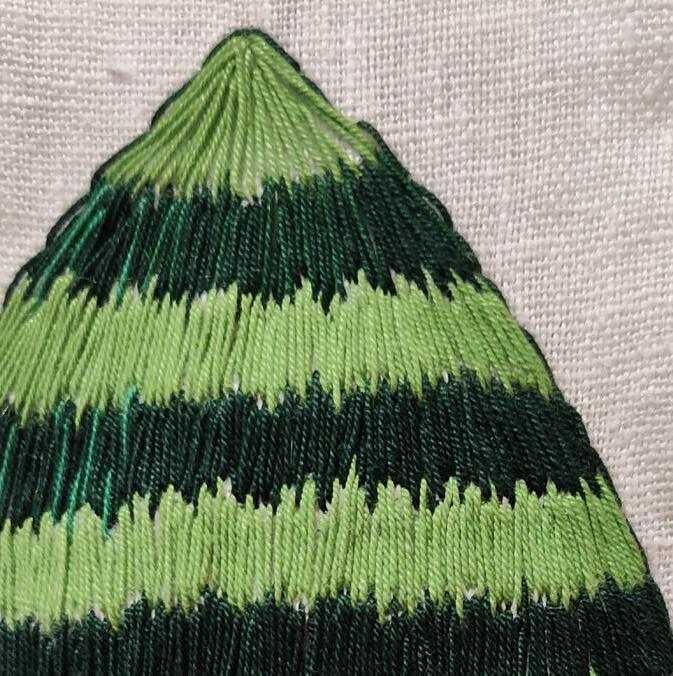
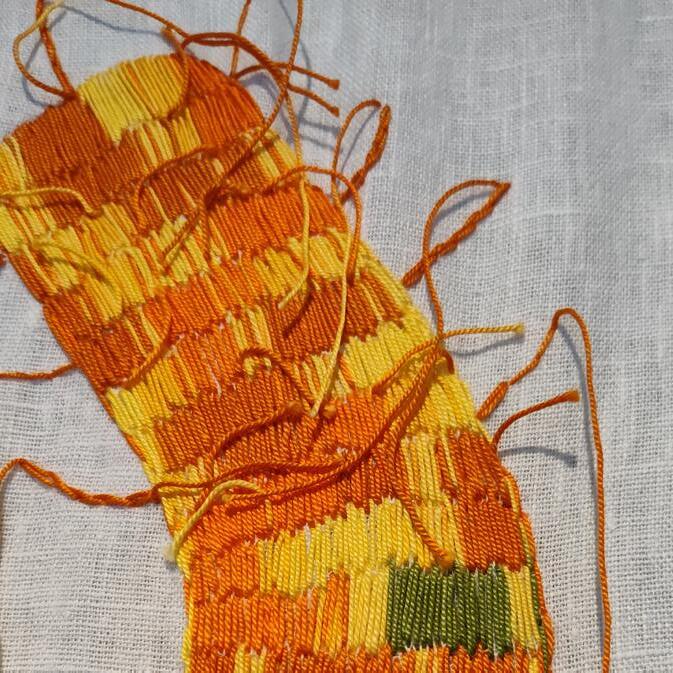
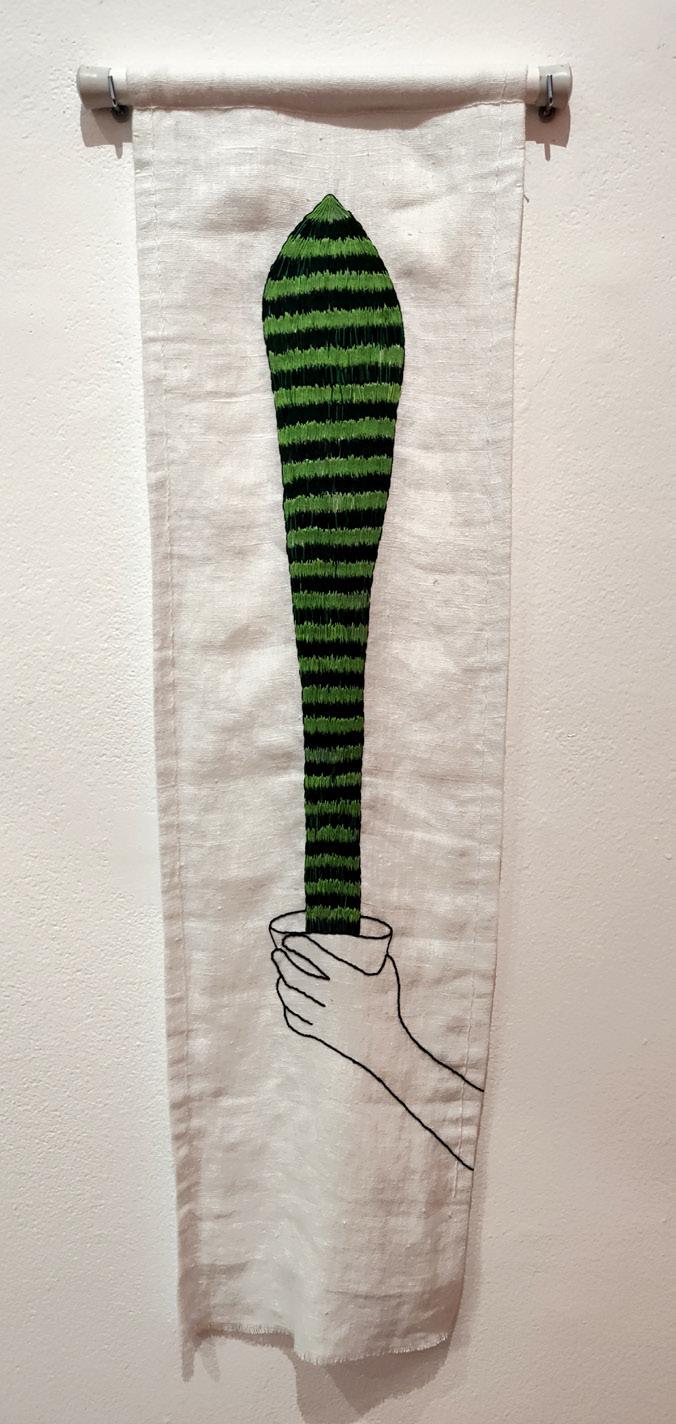


Each man acts for himself, according to his own plan, but the result is a social action, in which another plan, external to him, is realized; and with the raw, fine and undone threads of each one’s life, the stone web of history is woven.
A sharp word cuts like a knife. Its cutting edge is sharp and penetrating, with an ability to convey incisive messages in a deeper way... and, often, more painfully.

A sharp word also creates plots, weaves concepts and, thus, its threads lead to an expanded horizon... And, many times, it transforms preconceived ideas.
In times of general misinterpretation and intentional distortion of any text – be it a sentence or a speech – a platform of multiple possibilities such as Art is, therefore, a sharpener of meanings.
In the group exhibition A-FIAR, artists perfect their visions through embroidery. Historically seen as an ancestral and handcrafted female pastime, embroidery has been revisited in contemporary times as an important form of biographical and activist expression that is independent of gender, race, religion or age.

The same needle that pierces, unites. And here, artists come together to spin and sharpen senses. They point out wounds that have been open for a long time and no longer have room. They need to be sutured. Distinct supports and collective poetics are crossed, at the same time that fundamental social issues of our daily life are permeated. Hunger, gender identity, spirituality, armed conflicts, ableism, man’s relationship with the world... The act of embroidering is no longer a mere decoration to become a watchword, an awakening.
May this experience line up new strengths and sew new bonds so that increasingly sharp minds can weave an increasingly dignified existence.
Radij Pogodin Russian author
Isabel Portella and Filipe Chagas curators
* a play with the words sharpen (afiar) and spin (fiar).
Ana Bia Novais
Visual artist Ana Bia Novais (Rio de Janeiro) uses photography as the basis of her work, where she overlaps materials and techniques to promote new encounters and narratives that reframe and shift the story of herself, the people she photographs and the territories she observes.
In Walls, she uses a peripheral graphic element marked with thread to materialize the strength of women in facing everyday violence, often invisible, which also carries other issues of gender identity.

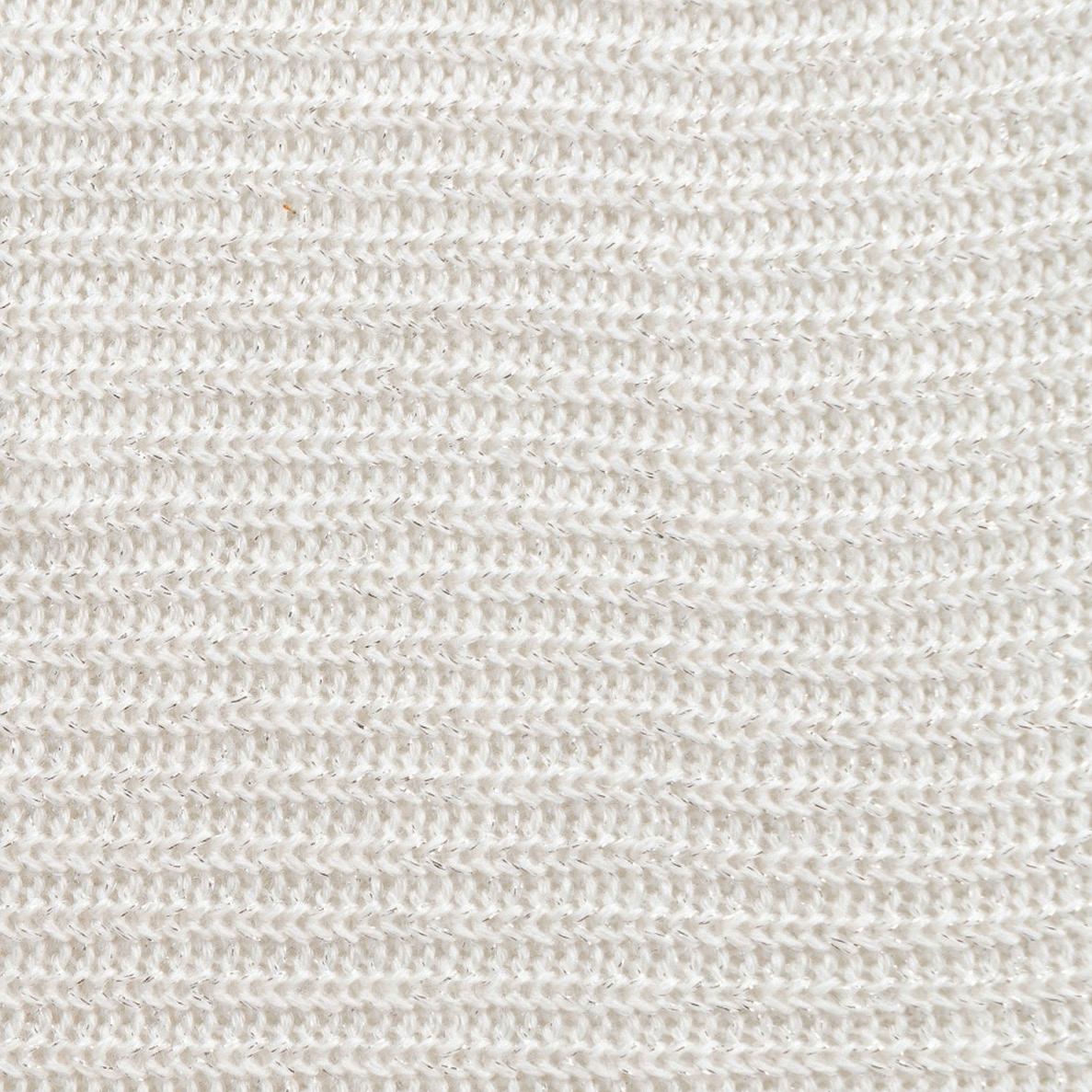
The artist participated in the group exhibitions Give a Path: Shared images and experiences, at the Museu de Arte do Rio, Quermesse, at Instituto Inclusartiz, and Masculinities in Dialogue, at Galpão Bela Maré. She is the creator of the Lambe das Manas project, where she promotes the free teaching of popular photography, the dissemination of this urban art language and the strengthening of dissident artists. Walls (2021), digital photography, lambe (poster) on offset paper embroidered with raw cotton thread and glue.
Bruna Amaro
The visual artist, performer and researcher Bruna Amaro (São Paulo) presents in her work a combination of academic research and themes related to Carnival, religiosity and gender violence in search of a reflection on textile making based on issues that circulate through the Brazilian reality.

The image of two biblical women who faced the violence inflicted by men is on their Carnival banners and accessories, to play with syncretism and remind you that the number of harassments against women suffers a vertiginous increase in this period. In To the left, the artist uses the colors red and black associated with Exus and Pombagiras to suggest interaction with both a political position and a religious identification.
Master in Aesthetics and Art History from USP and graduated in Visual Arts from UNESP, she has exhibited in salons throughout Brazil and abroad, with emphasis on the performance and installation Washing/Ablution, held at the Bouge B Festival, in Antwerp, together with Juliana dos Santos and Daniel Lie (2018); the Maneater project, carried out during an
artistic residency at Bethany Arts Community, in the USA (2019); and the performance and individual exhibition The Papangus, held in São Paulo and Berlin (2022).
Maneater - Salome (2019), rose branch, sequins and satin ribbon on fabric.
Artemisia vulgaris (2019), wood, sequins and satin ribbon on fabric.

Maneater - Judith (2019), rose branch, sequins and satin ribbon on fabric.
Your head is my hand, boy (2019), 3 pieces in brass bars, sequins and satin ribbon on fabric.
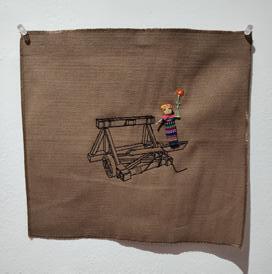
To the left (2020), acrylic paint on sequin embroidered on fabric.
Julie Brasil
Julie Brasil (RJ) is a visual artist and curator, graduated in Painting, Master in Visual Languages and PhD in Image and Culture from UFRJ. She taught Drawing, Image and Colonialism at the School
of Fine Arts at UFRJ, and Contemporary Art and Latin American Dictatorships at a private institution. She develops her production in
multiple media with particular interest in themes of politics, consumption, irony and violence. As an artist, she has participated in exhibitions at national and international institutions, such as Caixa Cultural, Instituto Cervantes, Kassel Video Festival and the Brazilian Museum of Sculpture, among others.
The girl who put a flower on a soldier’s rifle at a protest about the Vietnam War in Washington (USA). The young man who stood in front of an armored tank at a protest in Tiananmen Square in Beijing. Gestures of peace in moments of great tension lead the artist to the arsenal that her family kept at home during the civil war in Guatemala, her country of origin, and also to the Mayan legend of the Quitapenas, tiny guardian dolls that act as listeners, leading to the gods the concerns of those who address them with an open heart so that they can find a clearer and lighter way of resolving them. This resulted in the series of embroidered weapons that, at their points, carry a magic doll both as resistance and as ammunition for protection and peace.
Quitapenas Cannon (2023), Quitapenas Bazooka (2020), Quitapenas Pistol (2023), Quitapenas Archery (2020), Quitapenas Catapult (2023), Quitapenas CM176 (2020), manual and industrial embroidery on canvas and Quitapenas doll.
Langattomasti
The collective Langattomasti (Rio de Janeiro) – formed by the plastic artist and geoscientist Giselle
Parno and the artisan, textile artist and chemical engineer Thainá Melo – explores the developments of weaving to reflect on any and all forms of art with threads. Since 2014, they have been working on several fronts, with the purpose of rescuing and spreading the art of weaving yarn, whether in photographs, costumes, handicrafts or even urban interventions (yarn bombing) and “protest crochets”.
The images in this exhibition bring three interventions carried out by the collective: a crochet guitar on the bust of Chiquinha Gonzaga, located on the Passeio Público in Rio de Janeiro, representing the influence of Afrodescendant music in its repertoire and recalling the execution of the song “Corta-jaca” by the
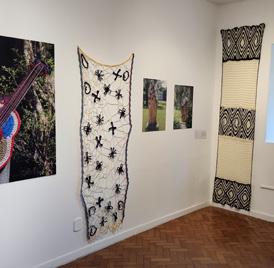
first lady of Hermes da Fonseca, Nair de Teffé, in a recital in the Salão Nobre of the Palácio do Catete; and two crocheted blankets containing symbols of the culture of enslaved and original peoples in the two terracotta female statues in the Catete Gardens, which seek to show that, despite being ornamented in a European way, the palace considered by and for the elite belongs to all peoples and cultures that make up this country.
Diaspora 2 (2023), photograph of yarn bombing on a terracotta statue, Catete Palace Gardens/Rio de Janeiro.
Diasporic blanket with indigenous graphics (2023), traditional cotton yarn crochet.
Diaspora 1 (2023), photograph of yarn bombing on a terracotta statue, Catete Palace Gardens/Rio de Janeiro.
Diasporic blanket with adinkras (2023), Irish cotton yarn crochet.
Maxixe (2023), photograph of yarn bombing at the statue of Chiquinha Gonzaga, Passeio Público/Rio de Janeiro.

Marcos Rossetton
Marcos Rossetton (São Paulo) investigates human, social and media behavior through polarized, antagonistic and subliminal messages, focusing on sexuality, awareness and respect for diversity. In the deconstruction of objects and in the use of different materials, he composes a unique signature, always provoking the spectator. Her embroideries are subversive and aim at disruptive questioning not only of the established order, but also of the traditional supports of the technique. In plastic lunch boxes, for example, the artist embroiders reflections on the isolation experienced by everyone during the pandemic, which, in fact, are intrinsic to contemporary times. After all, what nourishes our soul in difficult times? In times where we are spectators and victims of power struggles that came out of the wings to remain in everyday life? The hoop that is also part of the universe of embroidery is used to stretch the Amazonian latex crossed by images of the Brazilian capital city in favor of the capital.
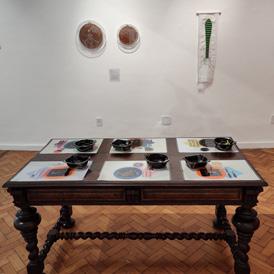
Graduated in Visual Arts, post-graduated in Image and Fashion Styling, and awarded at

the Casa de Criadores event, he did an artistic residency at the Museo Q in Bogotá. His works have already been shown at EroticArt London, the Biennale Internationale Design de SaintÉtienne, the Center de Design de Marseille, the National Historical Museum (Rio de Janeiro), the Museum of Sexual Diversity and the Cultural Center of Diversity (São Paulo).
Frozen lunch boxes! (2021), 6 plastic packages embroidered with thread and photographs on a placemat printed on PVC.
Behind the scenes of the nation: Faith in Agribusiness! (2020), latex, thread, needle and trimmings.

Behind the scenes of the nation: Gun in hand Indian on the ground (2020), latex and thread.
Mariana Vilela
Mariana Vilela (Minas Gerais) is a multimedia artist and activist. Master’s student in Scientific and Cultural Dissemination at Labjor / Unicamp, she has been working as a
performer since 2010, moving through visual arts, theater and literature. She has the line as a conceptual object and perspective of thinking and acting in the world.
To oppose the geological Era in which we live – marked by the impact of the presence of human beings on Earth, the Anthropocene – the artist proposes to think about plant lines with their cooperation, symbiosis and co-contamination, allowing themselves to be taken over by plants. With Vitaloceno, for a vegetable head, the artist makes possible other narratives and summons the vital force of plants as a central perspective in the creation of worlds.
She has participated in individual exhibitions and in several contemporary art salons in Brazil. She won the Funarte Award for Visual Arts-Periphery and Interior, in 2018, with the project In Dialogue. She was born in Belo Horizonte, and today lives in Campinas.
Nara Rosetto
From the experience of chronic diseases without cure, Nara Rosetto (São Paulo) uses the themes of vulnerability, invisibility, pain and body as recurrent subjects in her production. In Pepper in the other’s eye, a popular Brazilian expression was the reference to the use of pepper (a natural pain reliever) as a raw material for dyeing the threads that were braided in expressions that are rooted in our ableist society. The eighteen crochets in Small Gestures, on the other hand, take advantage of the contrast of white on white to make it difficult to read invisible feelings.


Vitalocene, for a plant head (2021), object made of line and cultivated plants and stills from the performance video.
Graduated in Architecture and Urbanism from Universidade Presbiteriana Mackenzie, she is a Master’s student in Intermediate Arts at the Faculty of Fine Arts of the University of Porto. She works in different supports such as textiles, video and photo performance, based on the experience of chronic diseases without cure. She participated in the blauverschiebung performance festival no.14, in Germany, Every Woman Biennial, in New York, Porto Femme in Porto and was part of the artistic residency Demonstra.pt. She lives and works in Porto, Portugal.
Pepper in the other’s eye (2018-2019), crochet in raw cotton yarn.

Small Gestures (2020-2023), 18 crochet objects in cotton yarn.
Rafael Dambros
With “needle painting”, the plastic artist Rafael Dambros (Caxias do Sul) uses the multiple colors of the sewing thread as raw material for tracing on a canvas. In his Saint Sebastian as a football player, the needle reflects the arrows of the martyrdom of the patron saint of Rio de Janeiro, who is exhaustively represented and syncretized in Brazil with Oxóssi, the orisha hunter of the forests. The overlapping of lines creates layers of light, shadow, readings and provocations. A new Brazilian icon appears, strong, free and full of contrasts: between classical representations and pop iconography, between homoeroticism and sexism in sport, between the sacred and the profane.
Her drawings and embroideries serve as an expression of LGBT identity and a space for discussion on social issues. In addition to
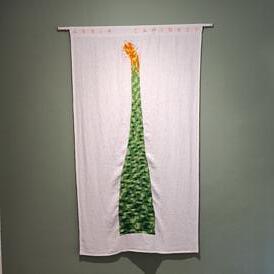
having works in public and private collections in Brazil and Europe, he participated in numerous individual and collective exhibitions in Caxias do Sul, Porto Alegre, Rio de Janeiro and also virtual. His most notable work was the exhibition Sanctified (2018), which brought rereadings of Catholic icons with contemporary languages that questioned social status. This exhibition was censored by the city of Caxias do Sul, however, it generated a huge discussion about freedom of artistic expression that took the exhibition to the City Council.
Saint Sebastian as a soccer player (2022), embroidered on canvas with white and gold acrylic paint background.
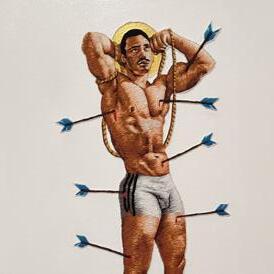
Yuli Anastassakis
Attentive to the repetition of words and expressions that indicated the direction of the nation, Yuli Anastassakis (Rio de Janeiro) began to carry out a mapping of discourses about the present time, where she found, in general, both a fear arising from ignorance and a potent hope laden with
affections. As a way of reacting to the moment we live in, she decided to associate her word search with the image of the Sword-of-SaintJorge, a very popular plant for being strong, resistant, living well in poor soils and with little irrigation, in addition to be seen as a form of protection against the evil eye and envy, especially in African-based religions. Thus, the artist opens the way for us to think about a new way of being in the world, of reflecting and acting, of communicating and cooperating.
Graduated in Social Sciences at IFCS / UFRJ, she has a master’s degree in Contemporary Artistic Processes from UERJ. She works as a producer of / for Art since 1998. As a visual artist she develops research in embroidery, collage, photography and painting. She participated in the artistic residencies The Sense of the Thread (Rio de Janeiro / 2018) and Flora (Rio de Janeiro / 2019). In 2021, she performed the solo show Times of Now, at Espaço NowHere, in Lisbon. She participated in several collectives in Rio de Janeiro, São Paulo and Lisbon. She lives and works in Lisbon.
Open ways (2023), thread on linen.

#protectionfordarktimes (2022), thread on linen.
March 4th to May 14th, 2023
tuesday to friday, from 10 am to 5 pm
saturday, sunday and holidays, from 11 am to 5 pm
Galeria do Lago –Museu da República
Rua do Catete 153, Catete – Rio de Janeiro - RJ @afiar_expo
#afiarexpo #expoafiar
#afiarnagaleriadolago


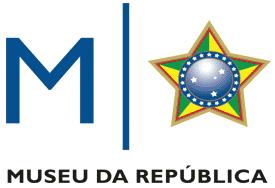
www.filipechagas.com












































































